Bearing Behavior of Engineered Cementitious Composite and Ultra-High-Performance Concrete Filled-In Double Steel Tubular Composite Columns Subjected to Eccentrical Load
Abstract
1. Introduction
2. Analysis Process of the Paper
3. Specimen Design
4. Finite Element Model (FEM)
4.1. Constitutive Model of Materials
4.1.1. Concrete and Steel Tubes
4.1.2. Constrained ECC Constitutive Model
4.2. Establishment of the Finite Element Model
4.2.1. Boundary Conditions and Contact Definitions
4.2.2. Mesh Subdivision
4.3. Experimental Verification of Finite Element Model
4.3.1. Verification of Nonlinear Constitutive Model Test of Constrained UHPC
4.3.2. Verification of FEM of Concrete-Filled Double Steel Tubular Composite Columns
4.3.3. Verification of Finite Element Model of Constrained ECC Composite Columns
5. Parameter Analysis
5.1. Load–Mid-Span Deflection (N-μm) Curve and Ductility Coefficient Curve
5.1.1. Strength of the Outer and Inner Steel Tubes (fy1, fy2)
5.1.2. Thickness of Outer and Inner Steel Tubes (t1, t2)
5.1.3. Eccentricity (e)
5.1.4. Diameter Ratio of Outer and Inner Steel Tubes (Ω)
5.1.5. Slenderness Ratio (λ)
5.1.6. Compressive Strength of UHPC Cylinder (fcu)
5.1.7. PVA Fiber Content (γ)
5.2. Analysis of Deformation Law of Full-Scale EUFDST Composite Columns under Eccentric Load
5.2.1. Lateral Deflection Curves
5.2.2. Longitudinal Strain Distribution Law of Mid-Span Section
5.2.3. Load–Strain Curve Analysis of Steel Tubes
6. Bending Stiffness Analysis
7. Contact Stress Analysis
8. The Whole Process Analysis of Full-Scale EUFDST Composite Columns under Eccentric Compression
8.1. Failure Modes
8.2. Force Mechanism and Force Analysis of the Whole Process
9. Maximum Load-Bearing Capacity Equation of Eccentrically Loaded Composite Long Columns
10. Conclusions
- (1)
- The maximum load-bearing capacity of the EUFDST composite columns under eccentric compression increases with the increase in the strength of inner and outer steel tubes (fy1, fy2), the thickness of inner and outer steel tubes (t1, t2), the compressive strength of the UHPC cylinder (fcu), the content of PVA (γ), and the diameter ratio of inner and outer steel tubes (Ω). With the slenderness ratio’s (λ) increase, the maximum load-bearing capacity of the EUFDST composite columns under eccentric compression decreases gradually. The initial stiffness of the EUFDST composite column gradually increases with the increase in the thickness of the inner and outer steel tubes (t1, t2), the compressive strength of the UHPC cylinder (fcu), the PVA content (γ), and the diameter ratio of the inner and outer steel tubes (Ω). However, as the slenderness ratio (λ) increases, the initial stiffness of the EUFDST composite column gradually decreases. When the strength of the inner and outer steel tubes varies from 235 MPa to 535 MPa, the initial stiffness of the EUFDST composite column remains unchanged. The ductility coefficient of the EUFDST composite column under eccentric load increases with the increase in the strength of the inner and outer steel tubes (fy1, fy2), the thickness of inner and outer steel tubes (t1, t2), and the content of PVA (γ). At the same time, with the increase in the compressive strength (fcu) and slenderness ratio (λ) of the UHPC cylinder, the ductility coefficient of the composite column decreases gradually. When the diameter ratio of the inner and outer steel tubes (Ω) changes in the range of 1.3–2, the ductility of the composite column increases with the increase in the diameter ratio. When the diameter ratio changes in the range of 2–2.5, the ductility of the composite column decreases.
- (2)
- The failure modes of all full-scale ECUFDST composite column specimens under eccentric load are similar, manifested as the outward buckling of the outer steel tube at the end of the compression zone and the ECC at the end of the compression zone. The inner and outer steel tubes in the mid-span are all subjected to yield failure. The concrete in the mid-span of the compression zone is crushed, and the concrete in the tension zone is cracked. Due to the special cross-section form of double steel tubes, the concrete in the tensile zone is mainly interlayer ECC, while the core UHPC mainly bears axial pressure, and the tensile part is less.
- (3)
- The EUFDST composite column is mainly divided into four stages under eccentric load: the elastic stage, elastic-plastic stage, stable stage, and failure stage. By introducing the slenderness ratio correction coefficient and the eccentricity correction coefficient, the calculation equation of the axial compression maximum load-bearing capacity of the full-scale EUFDST composite column is statistically regressed, and the finite element results are compared. The maximum error is 8.92%, which meets the engineering accuracy requirements.
- (4)
- For the EUFDST composite column, it is recommended to control the UHPC strength at 120 Mpa, which can maintain good ductility; the PVA fiber content is recommended to be controlled at 2%, which can effectively improve the bearing capacity and ductility. The thickness of the outer steel tube is recommended to be controlled at 15 mm, and the thickness of the inner steel tube is controlled at 20 mm. When the strength of the outer steel tube increases to 435 Mpa, the ductility increases significantly. It is recommended to control it at 435 Mpa. When the inner steel tube increases, the ductility coefficient increases linearly and can be controlled according to the actual situation. When the diameter ratio is about 1.5, the bearing capacity and ductility of the composite column can be improved with less material cost. For the composite column with large eccentricity, the diameter of the inner steel tube can be appropriately reduced. Taking the specimen in this paper as an example, the variation range can be controlled within 20 mm. For the composite column with a large slenderness ratio, there is no need to change the diameter ratio.
- (5)
- Compared to traditional steel tubular concrete columns, the bending resistance of EUFDST composite columns has been greatly improved. UHPC provides high load-bearing capacity, while the outer steel tube and ECC provide strong constraints. At the same time, the presence of ECC improves the ductility of the structure. In practical applications, combining the two reduces the impact of the high brittleness of UHPC and the low compressive strength of ECC. Inevitably, due to the high production costs of UHPC and ECC, the economic benefits of the EUFDST combination are relatively low, making it difficult to utilize widely.
Author Contributions
Funding
Data Availability Statement
Conflicts of Interest
References
- Ahmad, J.; Majdi, A.; Babeker Elhag, A.; Deifalla, A.F.; Soomro, M.; Isleem, H.F.; Qaidi, S. A Step towards Sustainable Concrete with Substitution of Plastic Waste in Concrete: Overview on Mechanical, Durability and Microstructure Analysis. Crystals 2022, 12, 944. [Google Scholar] [CrossRef]
- Ji, J.; Wang, W.; Jiang, L.; Ren, H.; Wang, Q.; Xuan, W.; Liu, Y. Bearing capacity of uhpc-filled high-strength elliptical steel tube composite columns with encased high-strength h-shape steel subjected to eccentrical load. Buildings 2022, 12, 1272. [Google Scholar] [CrossRef]
- Li, V.C. A simplified micromechanical model of compressive strength of fiber-reinforced cementitious composites. Cement. Concrete Comp. 1992, 14, 131–141. [Google Scholar] [CrossRef]
- Fischer, G.; Li, V.C. Effect of matrix ductility on deformation behavior of steel-reinforced ECC flexural members under reversed cyclic loading conditions. Aci Struct. J. 2002, 99, 781–790. [Google Scholar]
- Maalej, M.; Li, V.C. Flexural strength of fiber cementitious composites. J. Mater. Civil Eng. 1994, 6, 390–406. [Google Scholar] [CrossRef]
- Ji, J.; He, L.J.; Jiang, L.Q.; Zhang, Y.F.; Liu, Y.C.; Li, Y.H.; Zhang, Z.B. Numerical study on the axial compression behavior of composite columns with steel tube SHCC flanges and honeycombed steel web. Eng. Struct. 2023, 283, 115883. [Google Scholar] [CrossRef]
- Xu, S.L.; Li, H.D. Research progress and engineering application of ultra-high toughness cementitious composites. China Civil Eng. J. 2008, 6, 45–60. [Google Scholar]
- Jaf, D.K.I.; Abdulrahman, P.I.; Mohammed, A.S.; Kurda, R.; Qaidi, S.M.A.; Asteris, P.G. Machine learning techniques and multi-scale models to evaluate the impact of silicon dioxide (SiO2) and calcium oxide (CaO) in fly ash on the compressive strength of green concrete. Constr. Build. Mater. 2023, 400, 132604. [Google Scholar]
- Ji, J.; Zhang, Z.; Lin, M.; Li, L.; Jiang, L.; Ding, Y.; Yu, K. Structural Application of Engineered Cementitious Composites (ECC): A State-of-the-Art Review. Constr. Build. Mater. 2023, 406, 133289. [Google Scholar] [CrossRef]
- Ahmed, M.; Liang, Q.Q.; Patel, V.I.; Hadi, M.N. Numerical analysis of axially loaded circular high strength concrete-filled double steel tubular short columns. Thin Walled Struct. 2019, 138, 105–116. [Google Scholar] [CrossRef]
- Ahmed, M.; Liang, Q.Q.; Patel, V.I.; Hadi, M.N. Experimental and numerical studies of square concrete-filled double steel tubular short columns under eccentric loading. Eng. Struct. 2019, 197, 109419. [Google Scholar] [CrossRef]
- Ci, J.; Mizan, M.A.; Tran, V.-L.; Jia, H.; Chen, S. Axial compressive behavior of circular concrete-filled double steel tubular short columns. Adv. Struct. Eng. 2022, 25, 259–276. [Google Scholar] [CrossRef]
- Hu, J.; Huang, Y.; Li, W.; Zhang, S.; Rao, S. Compressive behavior of UHPC-filled square high-strength steel tube stub columns under eccentric loading. J. Constr. Steel Res. 2022, 198, 107558. [Google Scholar] [CrossRef]
- Cai, J.; Pan, J.; Tan, J.; Vandevyvere, B.; Li, X. Behavior of ECC-encased CFST columns under eccentric loading. J. Build. Eng. 2020, 30, 101188. [Google Scholar] [CrossRef]
- Chai, X.W.; Xie, Q.; Wang, X. Experimental study on tensile properties of hybrid fiber high toughness cementitious composites. J. Build. Struct. 2022, 43, 353–361. [Google Scholar]
- Ci, J.C.; Mizan, A.; Liang, Q.Q.; Chen, S.C.; Chen, W.S.; Sennah, K.; Hamoda, A. Experimental and numerical investigations into the behavior of circular concrete-filled double steel tubular slender columns. Eng. Struct. 2022, 267, 114644. [Google Scholar] [CrossRef]
- Liu, W.; Han, L.H. Study on the working mechanism of concrete filled steel tube under axial local compression load. China Civil Eng. J. 2006, 39, 19–27. [Google Scholar]
- Tao, Z.; Wang, Z.B.; Yu, Q. Finite element modeling of concrete-filled steel stub columns under axial compression. J. Constr. Steel Res. 2013, 89, 121–131. [Google Scholar] [CrossRef]
- Lam, L.; Teng, J.G. Design-Oriented Stress-Strain Model for FRP-Confined Concrete. Constr. Build. Mater. 2003, 17, 471–489. [Google Scholar] [CrossRef]
- Mander, J.B.; Priestley, M.J.N.; Park, R. Theoretical Stress-strain Model for Confined Concrete. J. Struct. Eng. 1988, 114, 1804–1826. [Google Scholar] [CrossRef]
- Pagoulatou, M.; Sheehan, T.; Dai, X.H. Finite element analysis on the capacity of circular concrete-filled double-skin steel tubular (CFDST) stub columns. Eng. Struct. 2014, 72, 102–112. [Google Scholar] [CrossRef]
- Montuori, R.; Piluso, V.; Tisi, A. Comparative analysis and critical issues of the main constitutive laws for concrete elements confined with FRP. Compos. Part B-Eng. 2012, 43, 3219–3230. [Google Scholar] [CrossRef]
- Montuori, R.; Piluso, V.; Tisi, A. Ultimate behaviour of FRP wrapped sections under axial force and bending: Influence of stress-strain confinement model. Compos. Part B-Eng. 2013, 54, 85–96. [Google Scholar] [CrossRef]
- Li, Y.; Liang, X.W.; Deng, M.K. Constitutive Model of High-Performance PVA Fiber Reinforced Cementitious Composites under Conventional Triaxial Compression. Eng. Mech. 2012, 29, 106–113. [Google Scholar]
- Wang, Y.K. Research on Seismic Performance of ECC Bridge Piers. Master’s Thesis, Shandong University, Jinan, China, 2021. [Google Scholar]
- Xiong, M.X.; Xiong, D.X.; Liew, J.Y.R. Axial performance of short concrete filled steel tubes with high- and ultra-high-strength materials. Eng. Struct. 2017, 136, 494–510. [Google Scholar] [CrossRef]
- Luo, X.; Wei, J.G. Experimental study on eccentric compression performance of ultra-high strength concrete filled high strength steel tube. J. Build. Struct. 2021, 42, 271–277. [Google Scholar]
- Wei, J.G.; Luo, X.; Ou, Z.J.; Chen, B.C. Experimental study on axial compression behavior of ultra-high performance concrete filled circular high strength steel tube short columns. J. Build. Struct. 2020, 41, 16–28. [Google Scholar]
- Zhang, Y.X.; Deng, M.; Li, R.Z. Axial behavior of engineered cementitious composites confined by circular steel tubes. Eng. Struct. 2020, 224, 112216. [Google Scholar] [CrossRef]
- Zhang, Z.; Wu, X.; Hu, G.; Sun, Q. Numerical study on triaxial compressive behavior of engineered cementitious composites confined by circular steel tubes. Constr. Build. Mater. 2022, 345, 128285. [Google Scholar] [CrossRef]
- Mao, M.; Tong, K.T.; Zhang, J.L.; Liu, T.; Li, Y. Experimental study on the mechanical performance of steel-bamboo composite I-section columns under eccentric loading. J. Build. Struct. 2021, 42, 126–135. [Google Scholar]
- Jiang, L.; Wang, W.; Ji, J.; Ren, H.; Wang, Q.; Sun, R.; Yu, C.; Zhang, H.; Luo, G. Bearing behavior of high-performance concrete-filled high-strength steel tube composite columns subjected to eccentrical load. Front. Mater. 2022, 9, 972811. [Google Scholar] [CrossRef]
- Ji, J.; Yu, D.Y.; Jiang, L.Q. Study on axial compression bearing capacity of solid-web double steel tube reinforced concrete composite short column. Build. Struct. 2020, 50, 120–129. [Google Scholar]
- GB 50936-2014; Technical Code for Concrete-Filled Steel Tubular Structures. China Architecture & Building Press: Beijing, China, 2014.
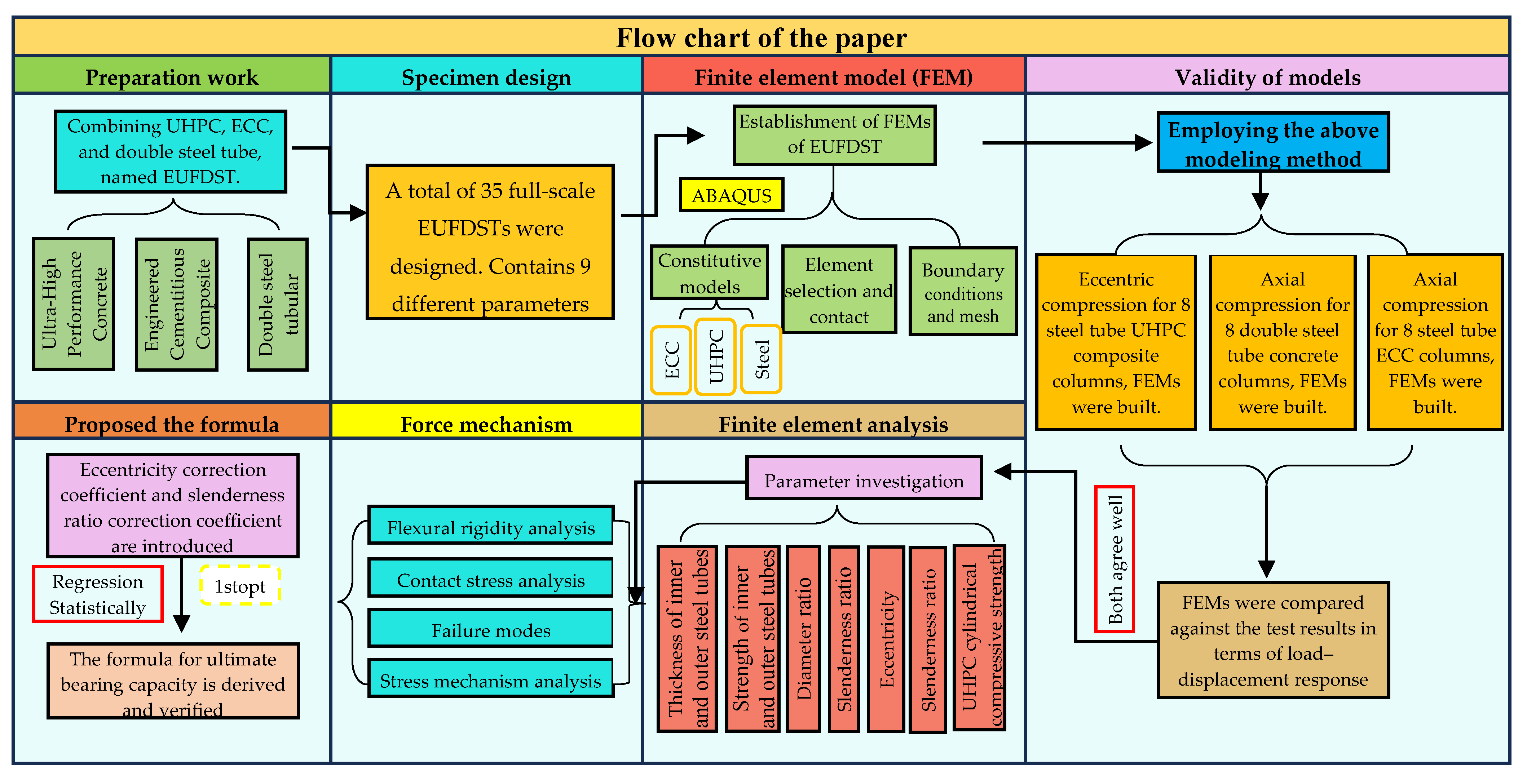
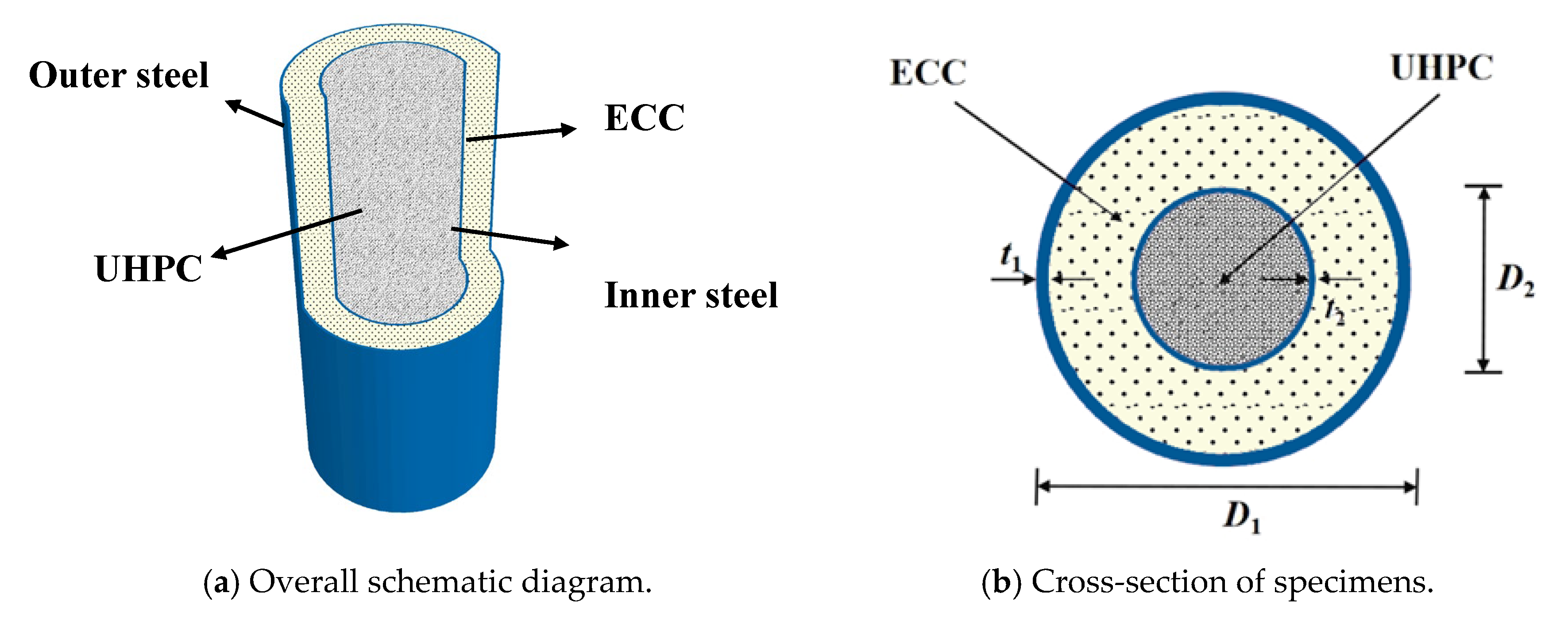
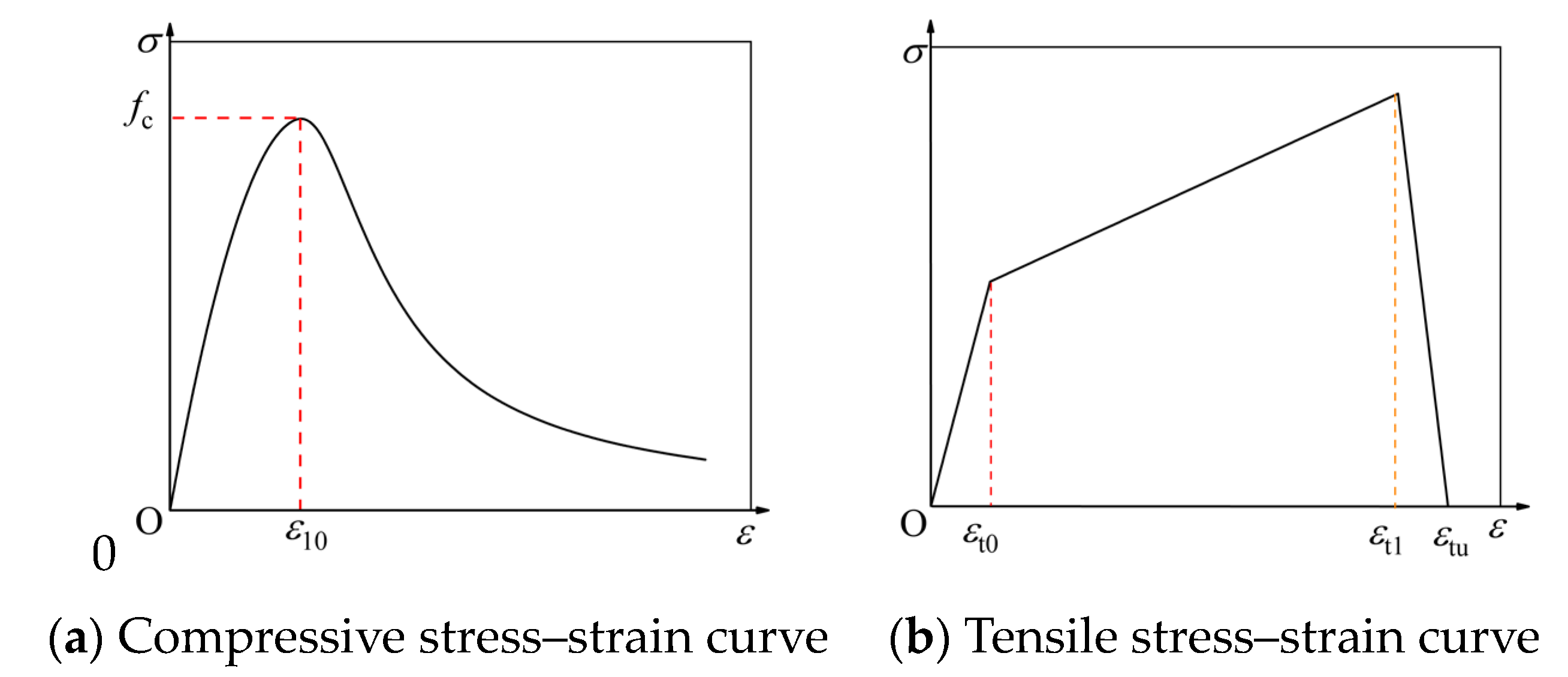

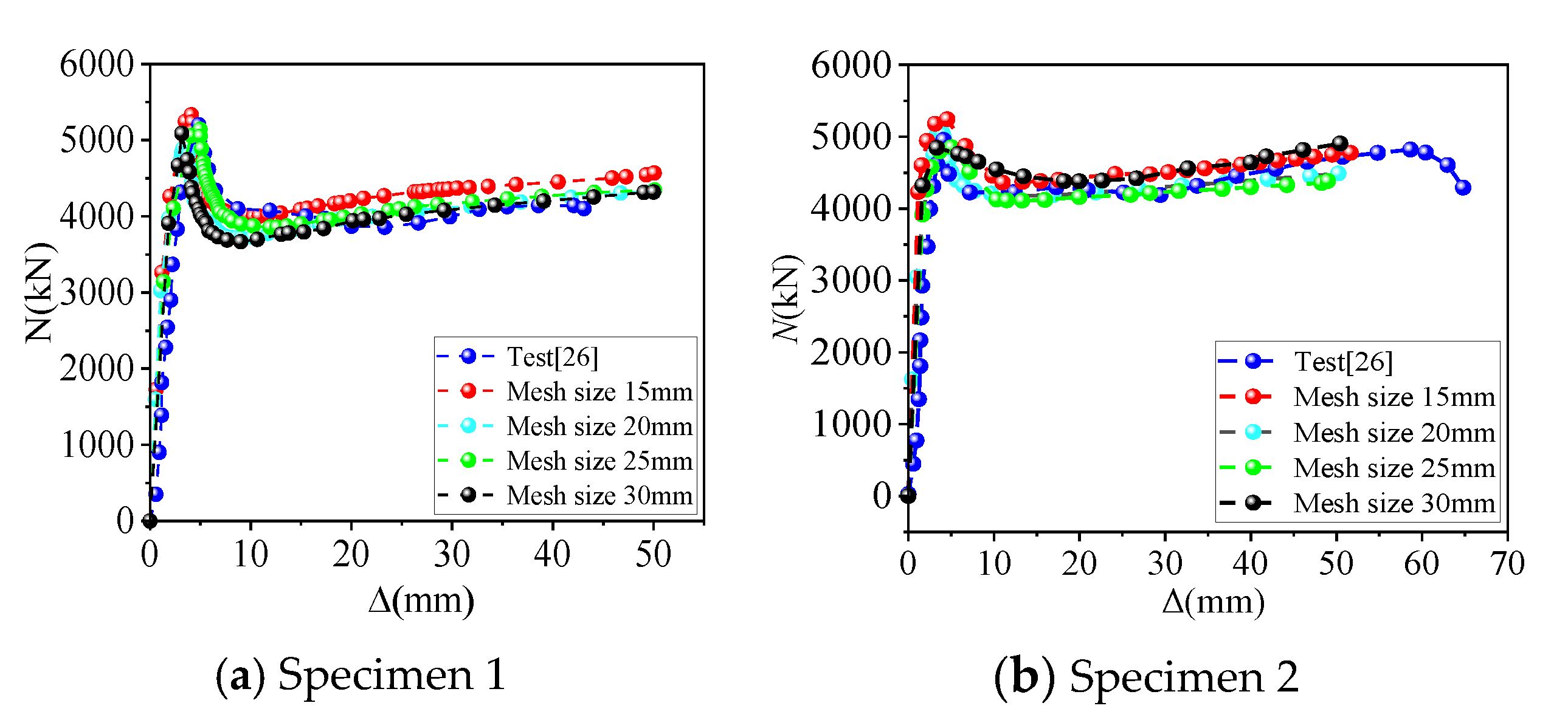

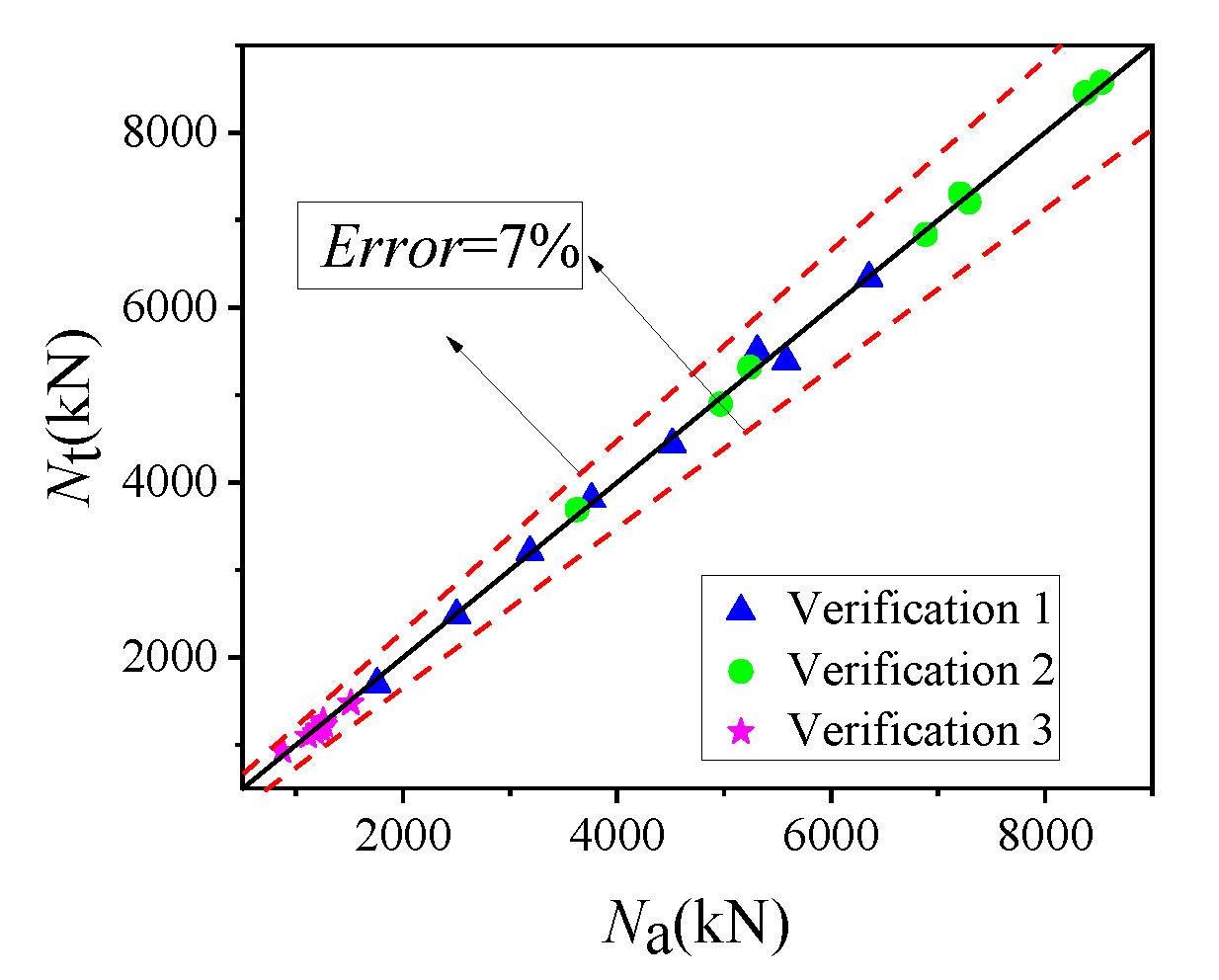
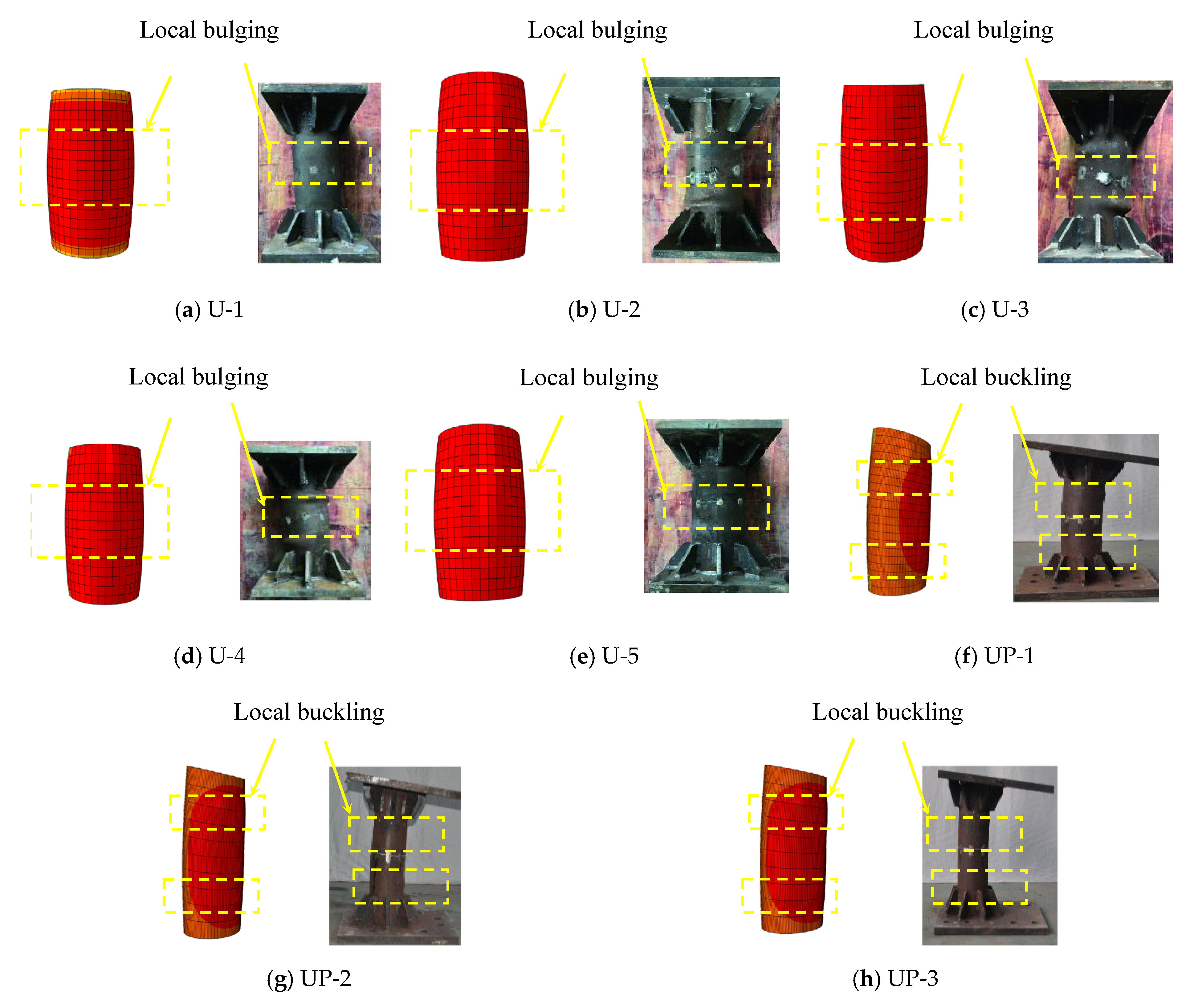
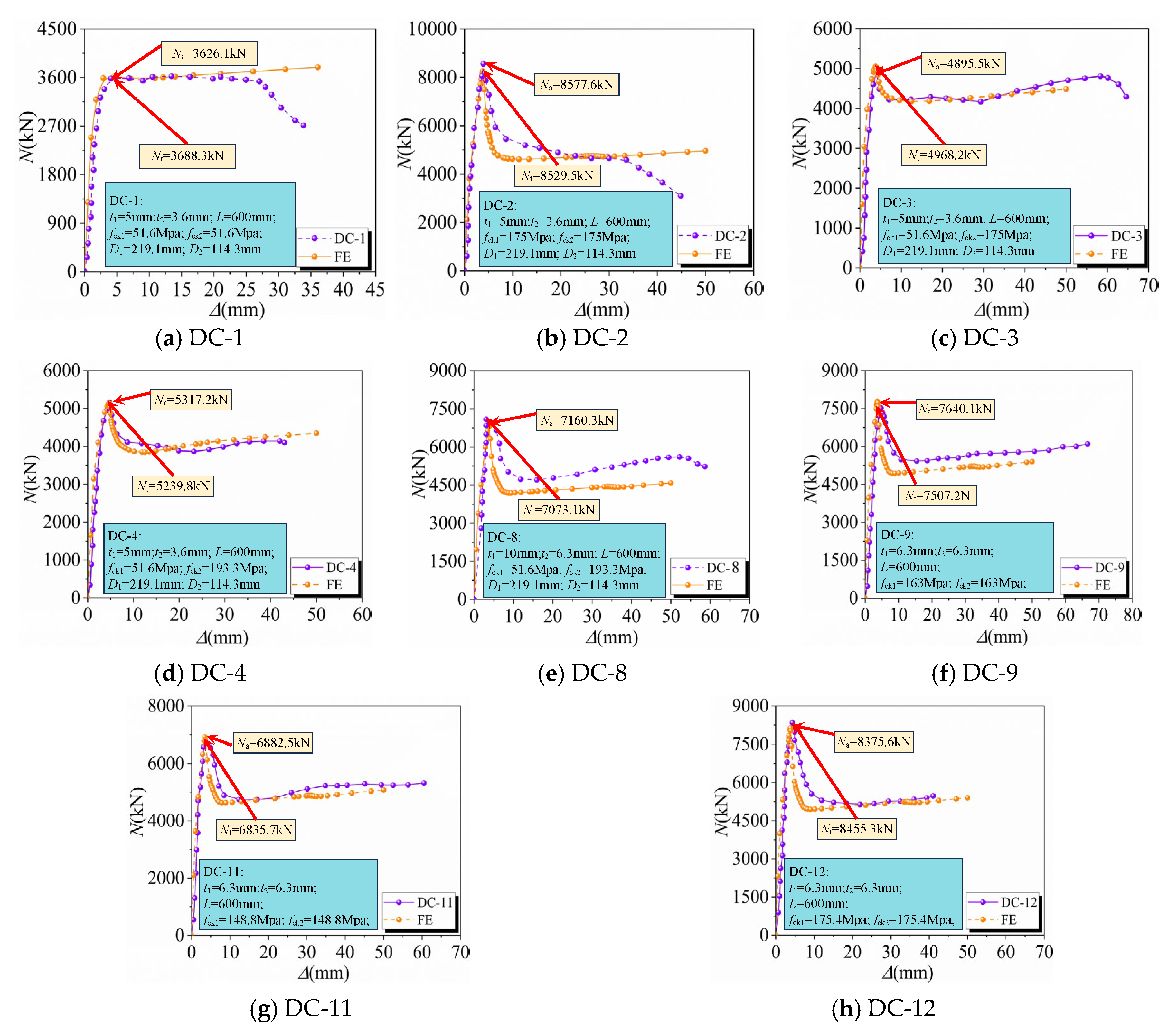


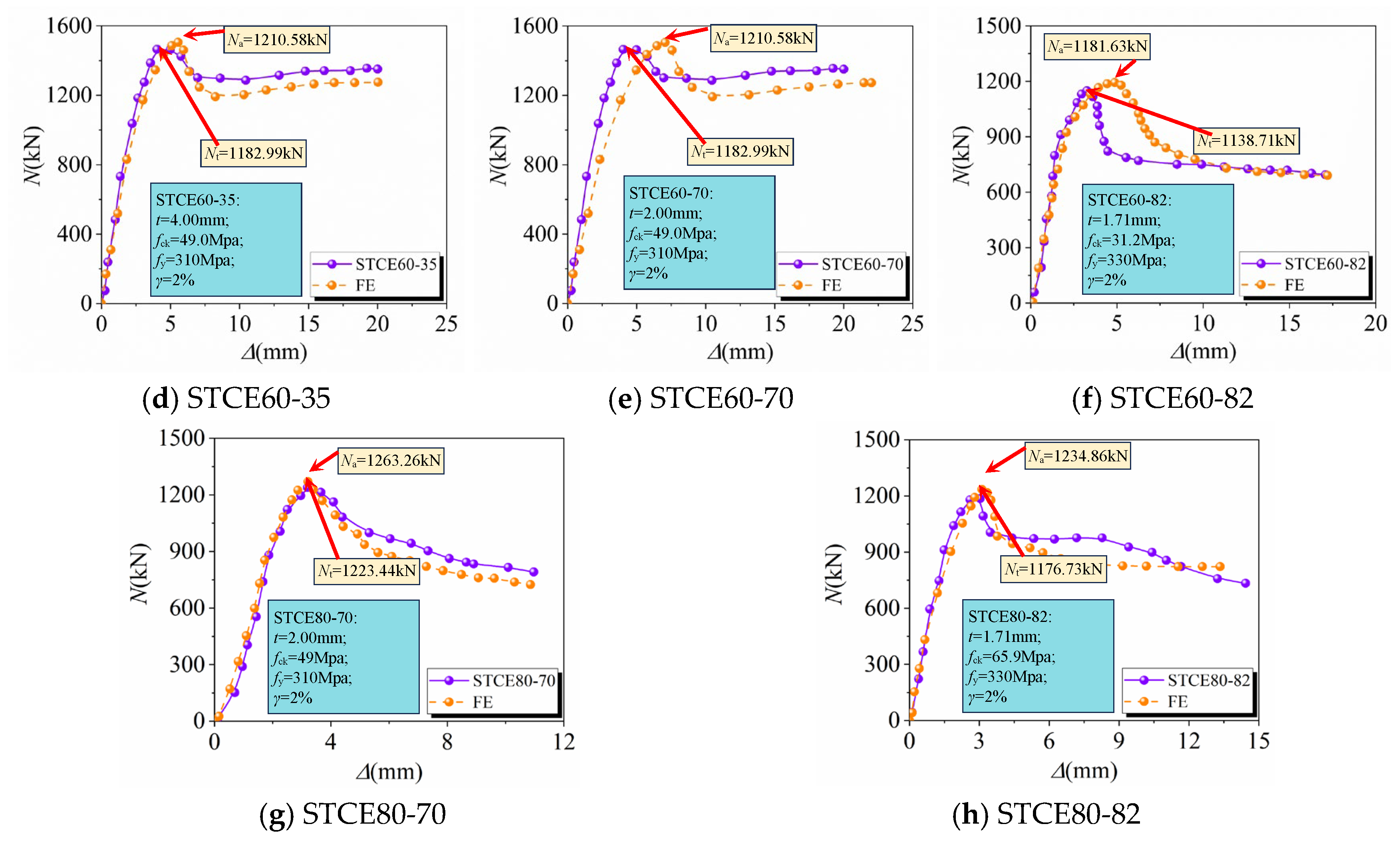
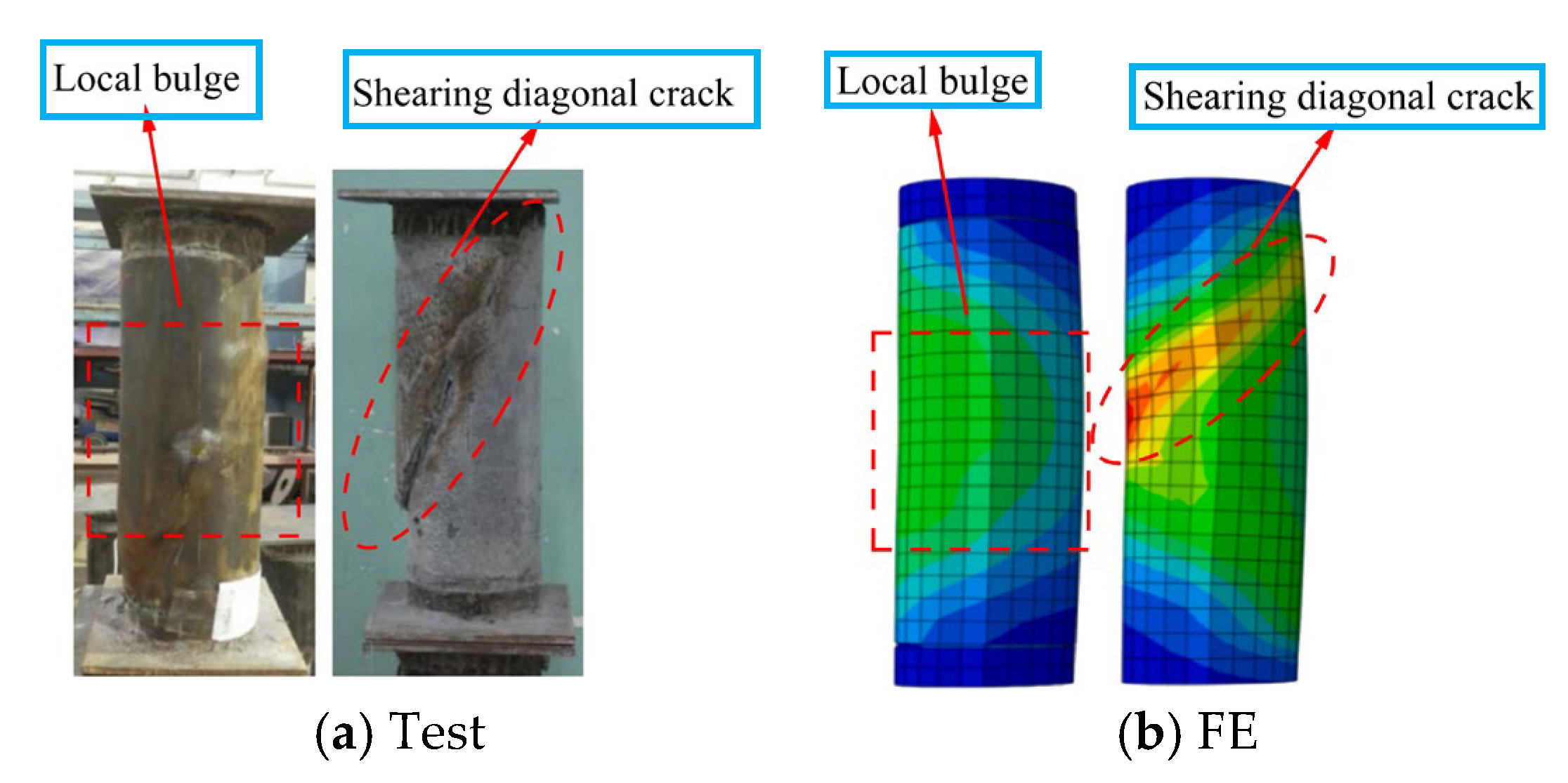
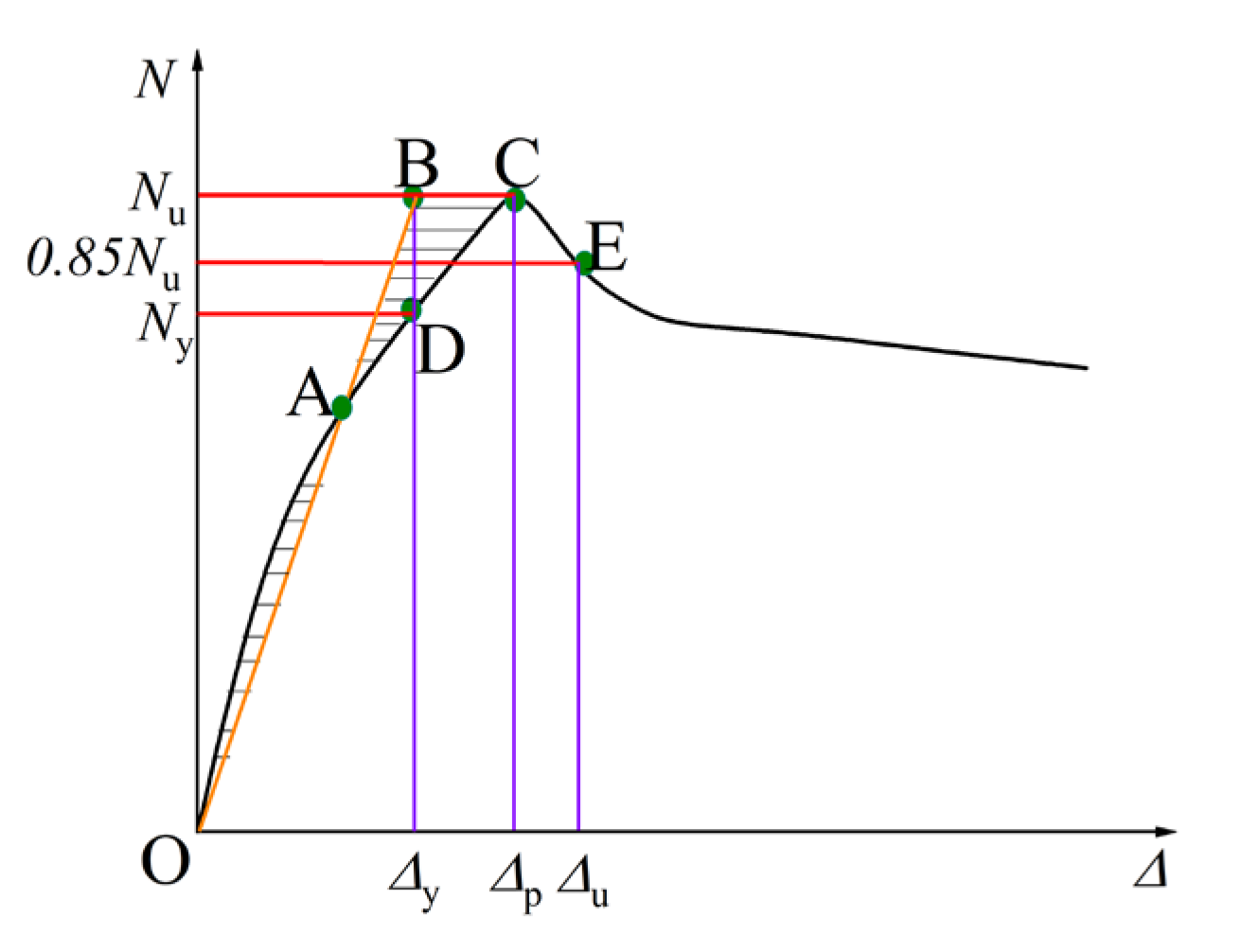

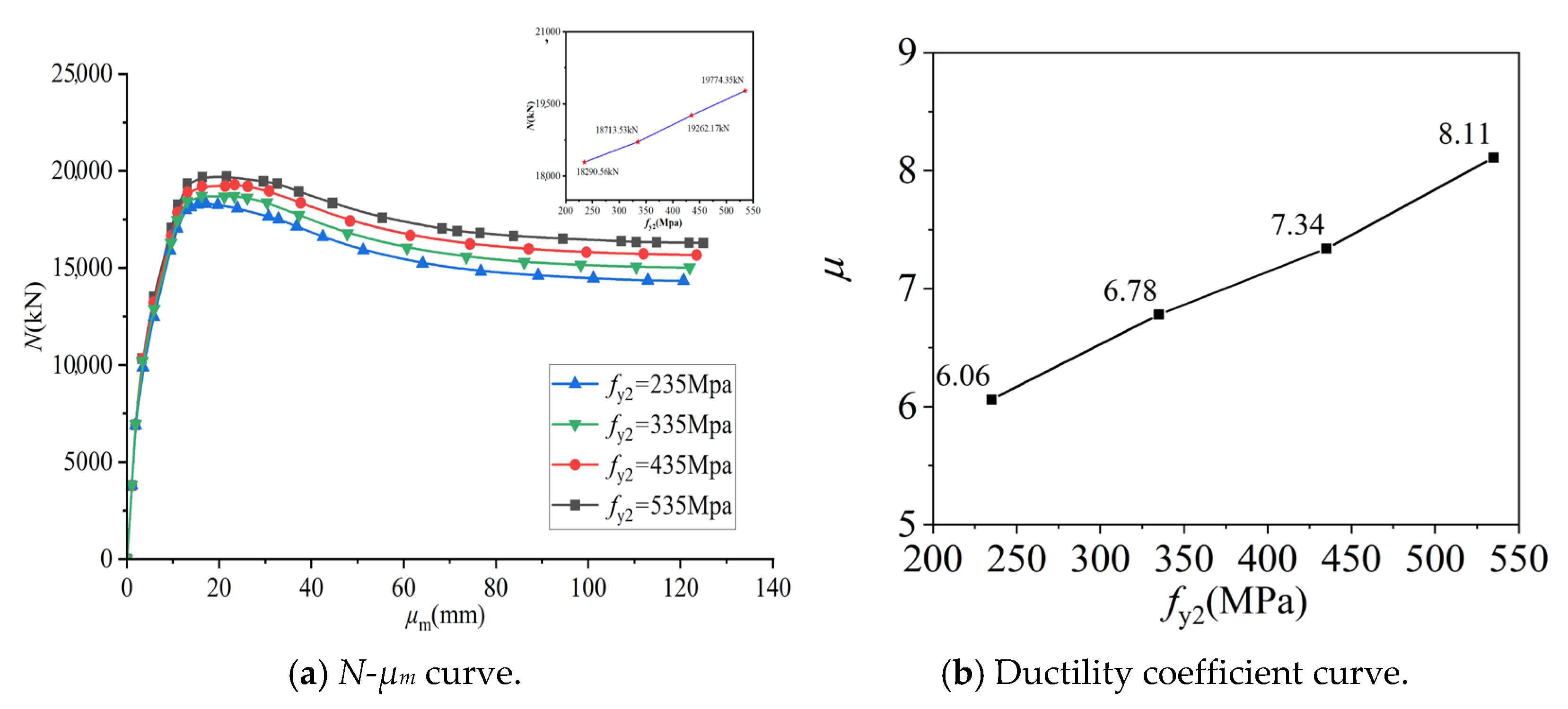
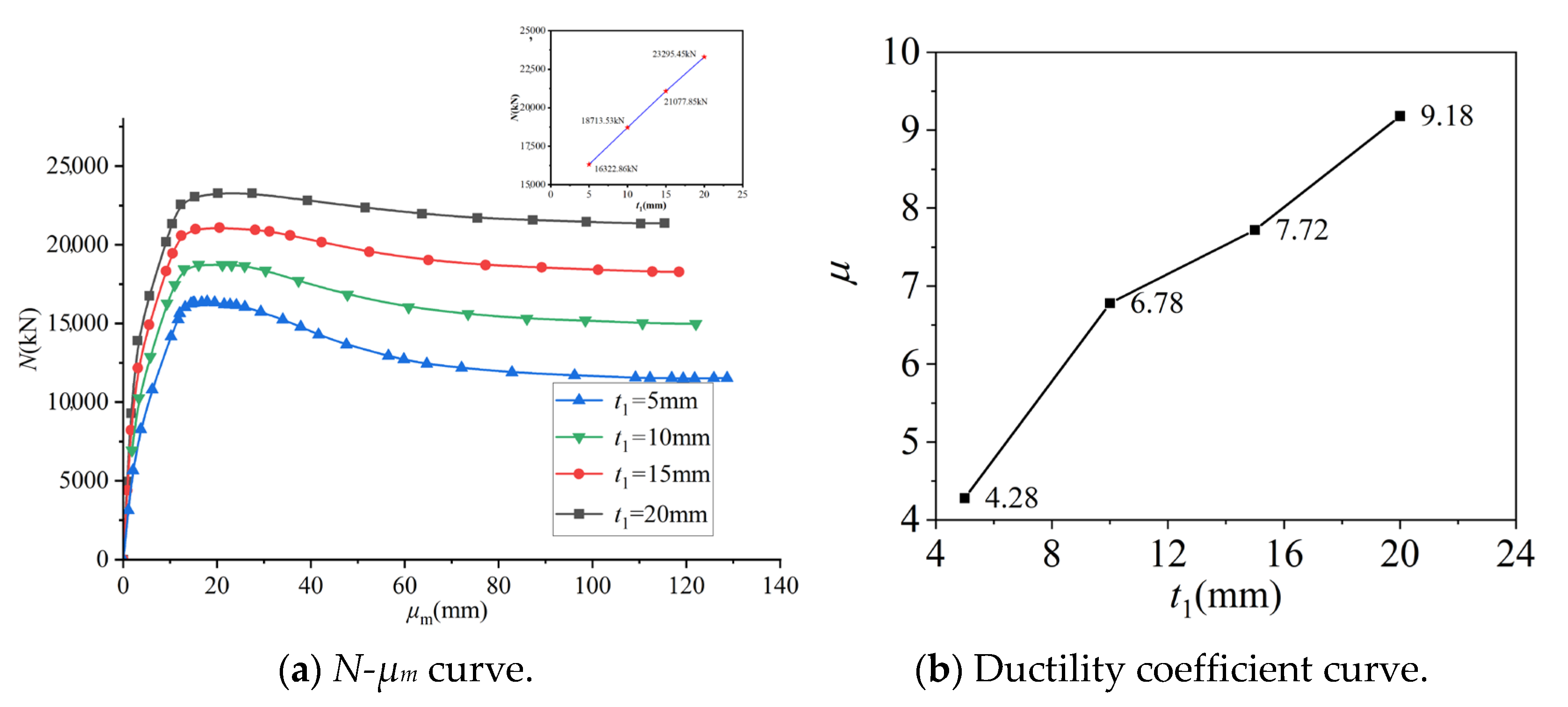
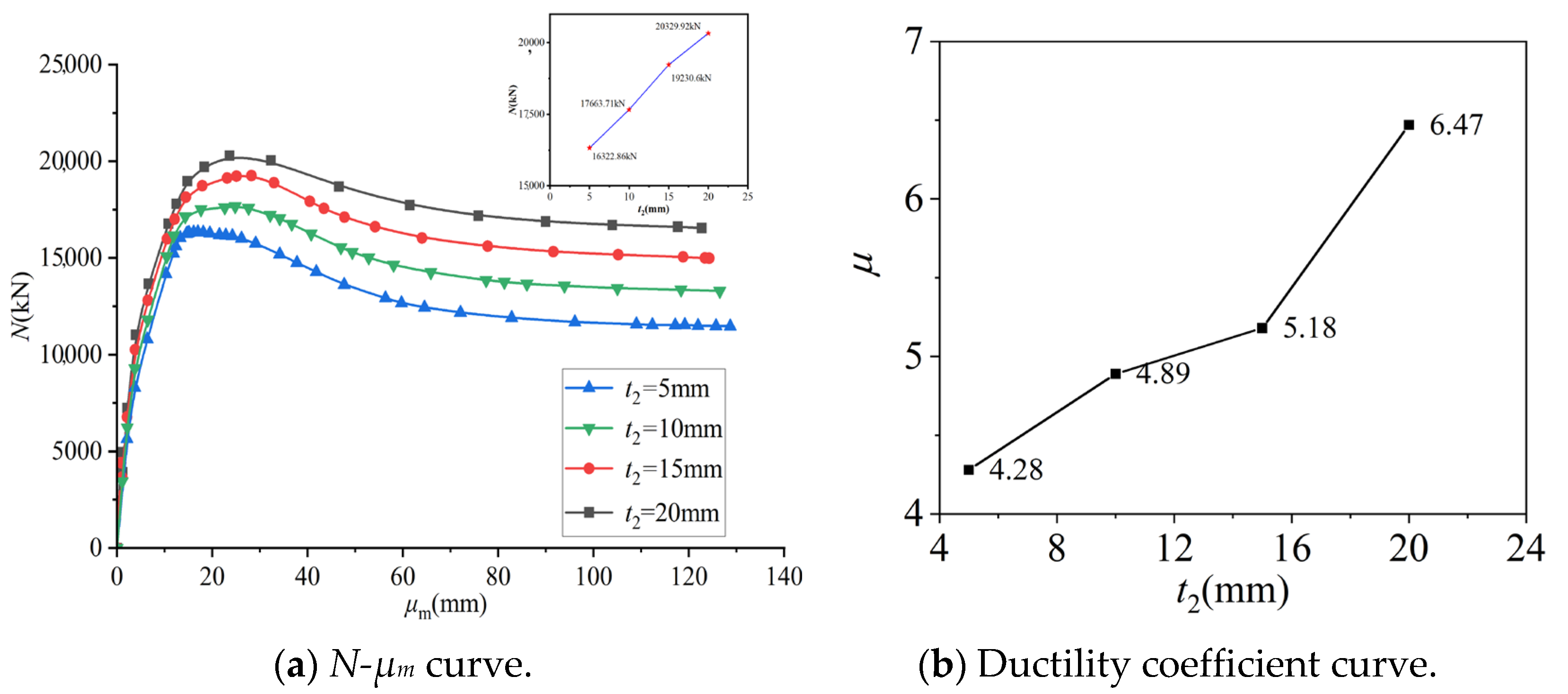
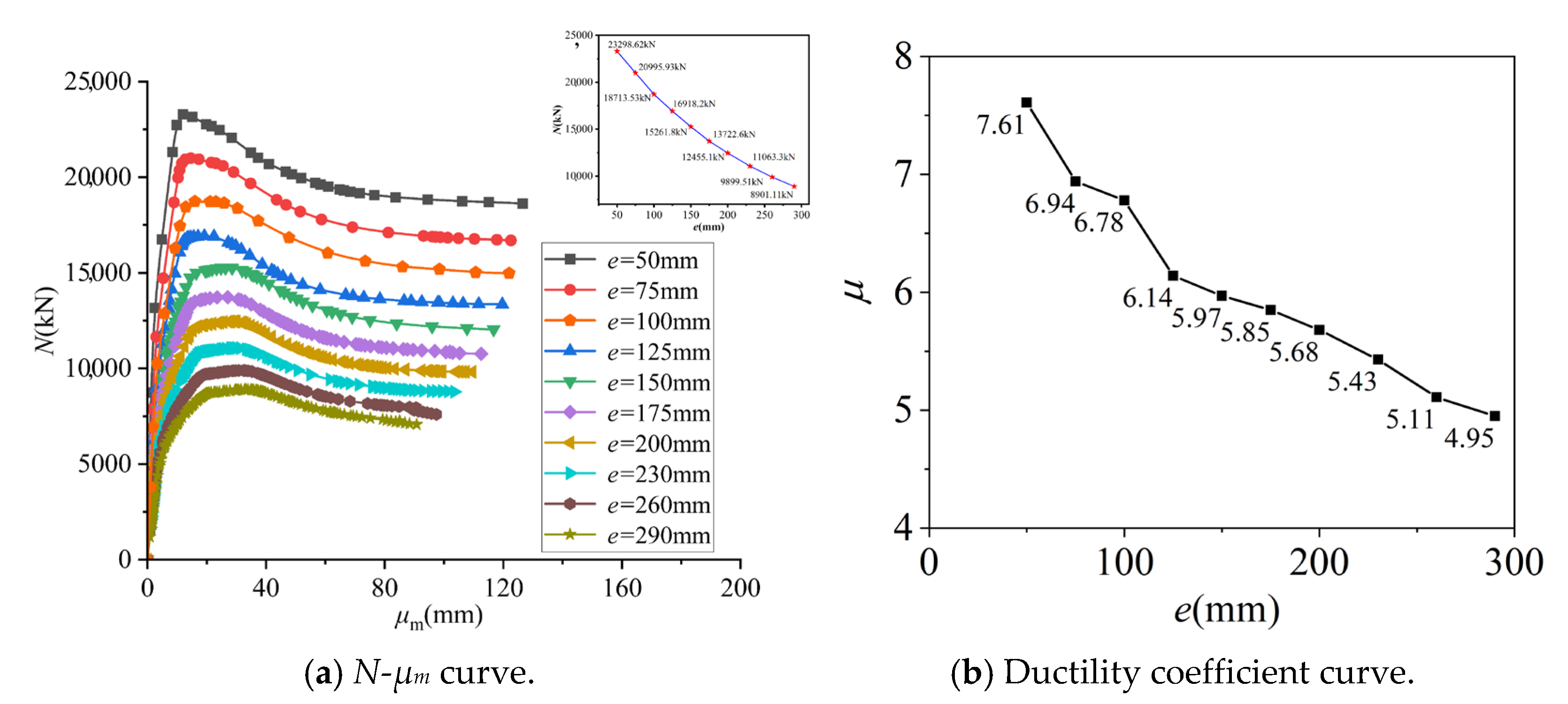
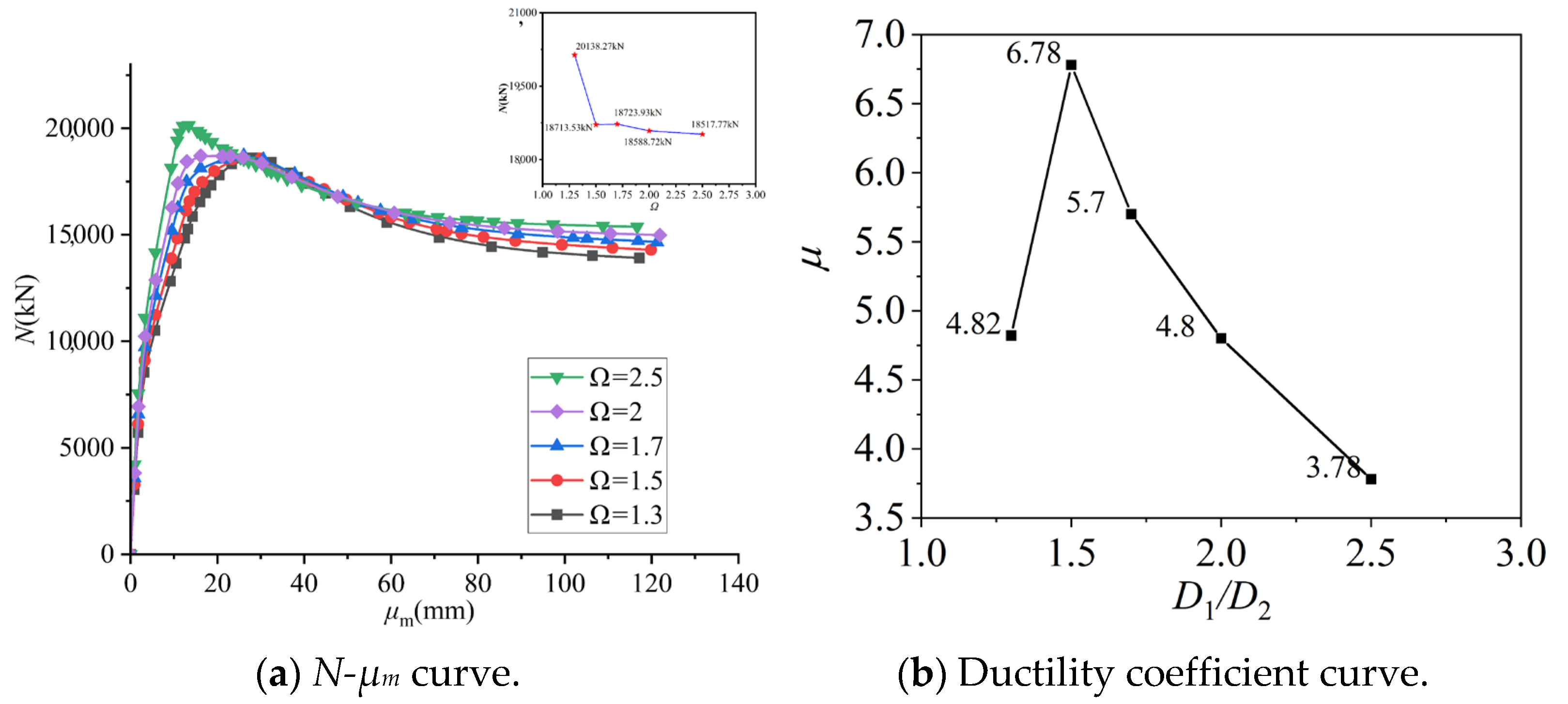
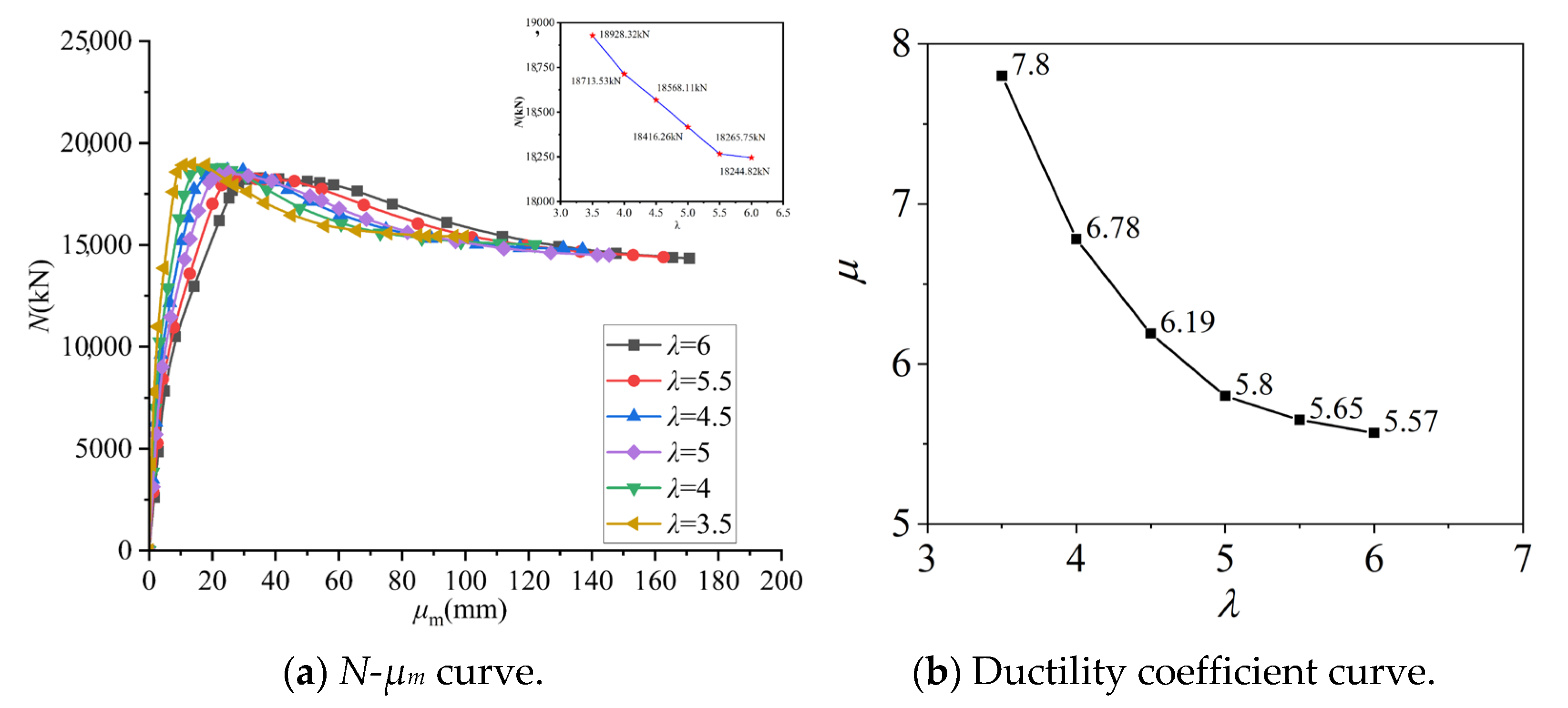
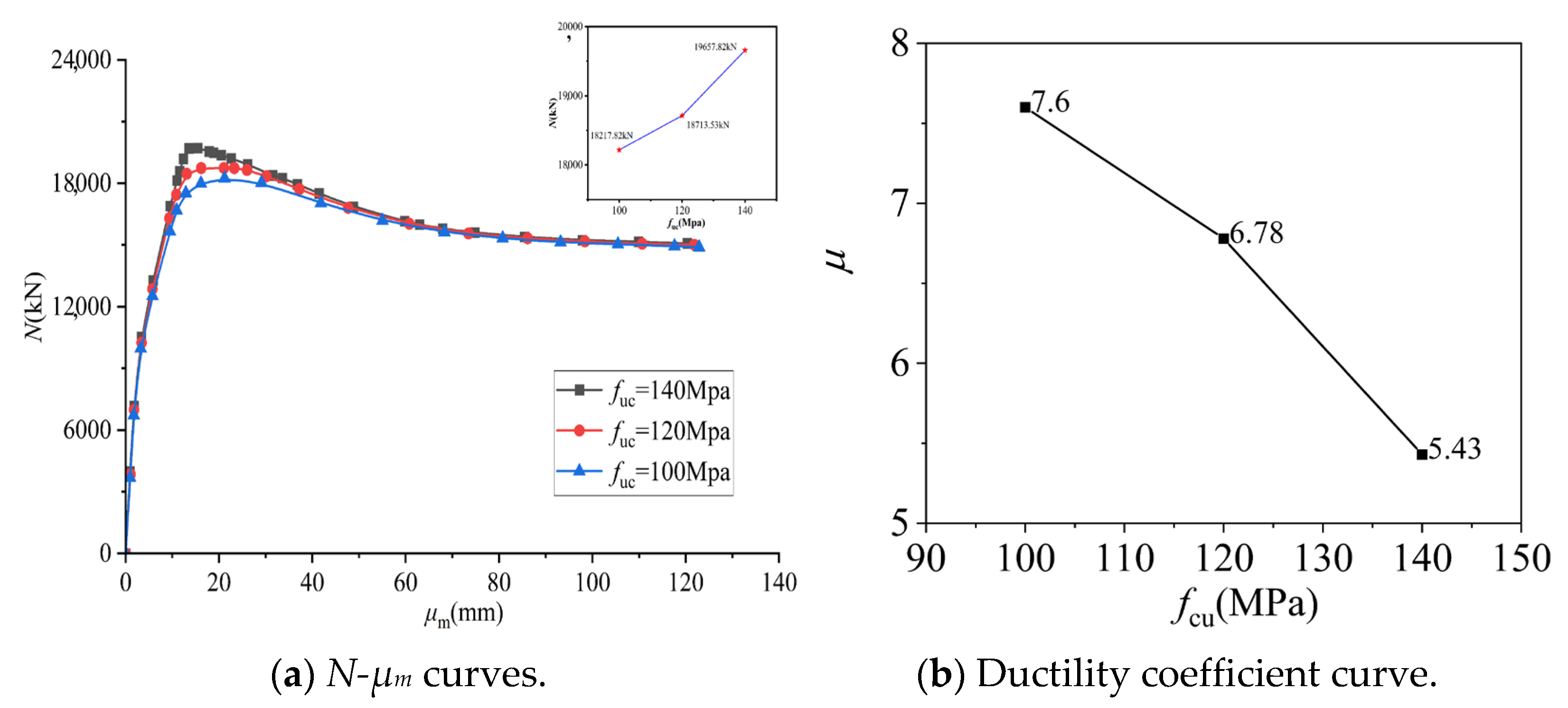
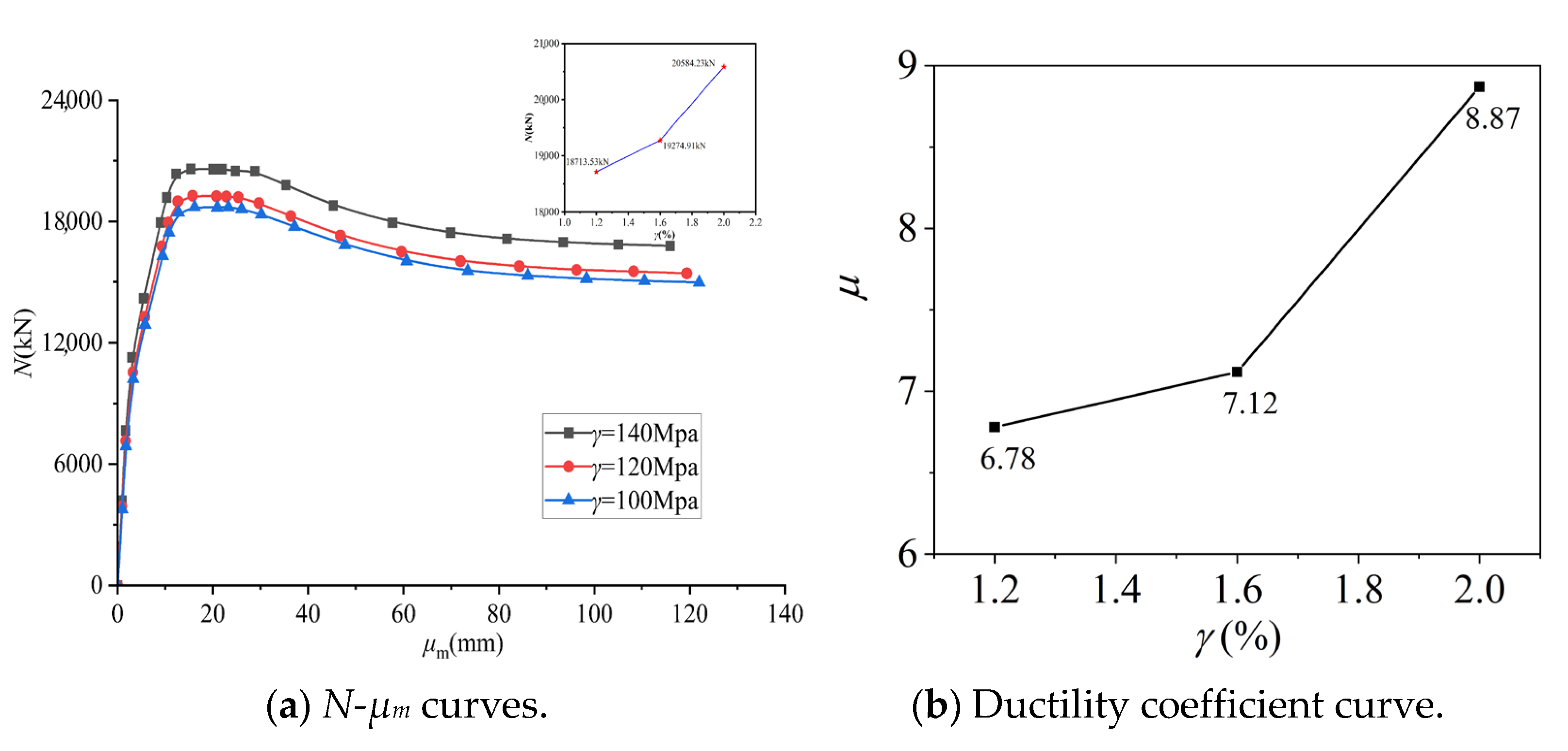
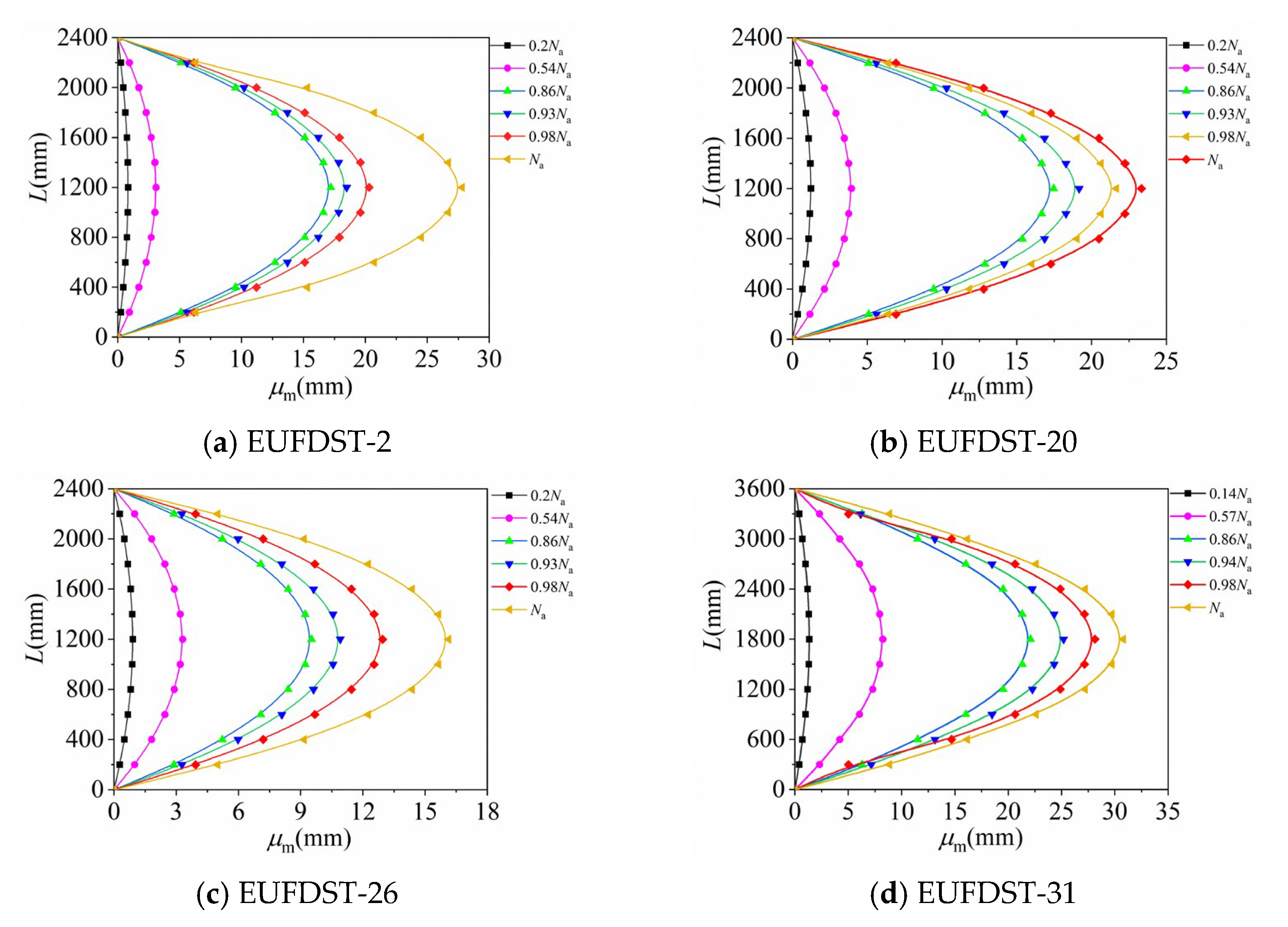
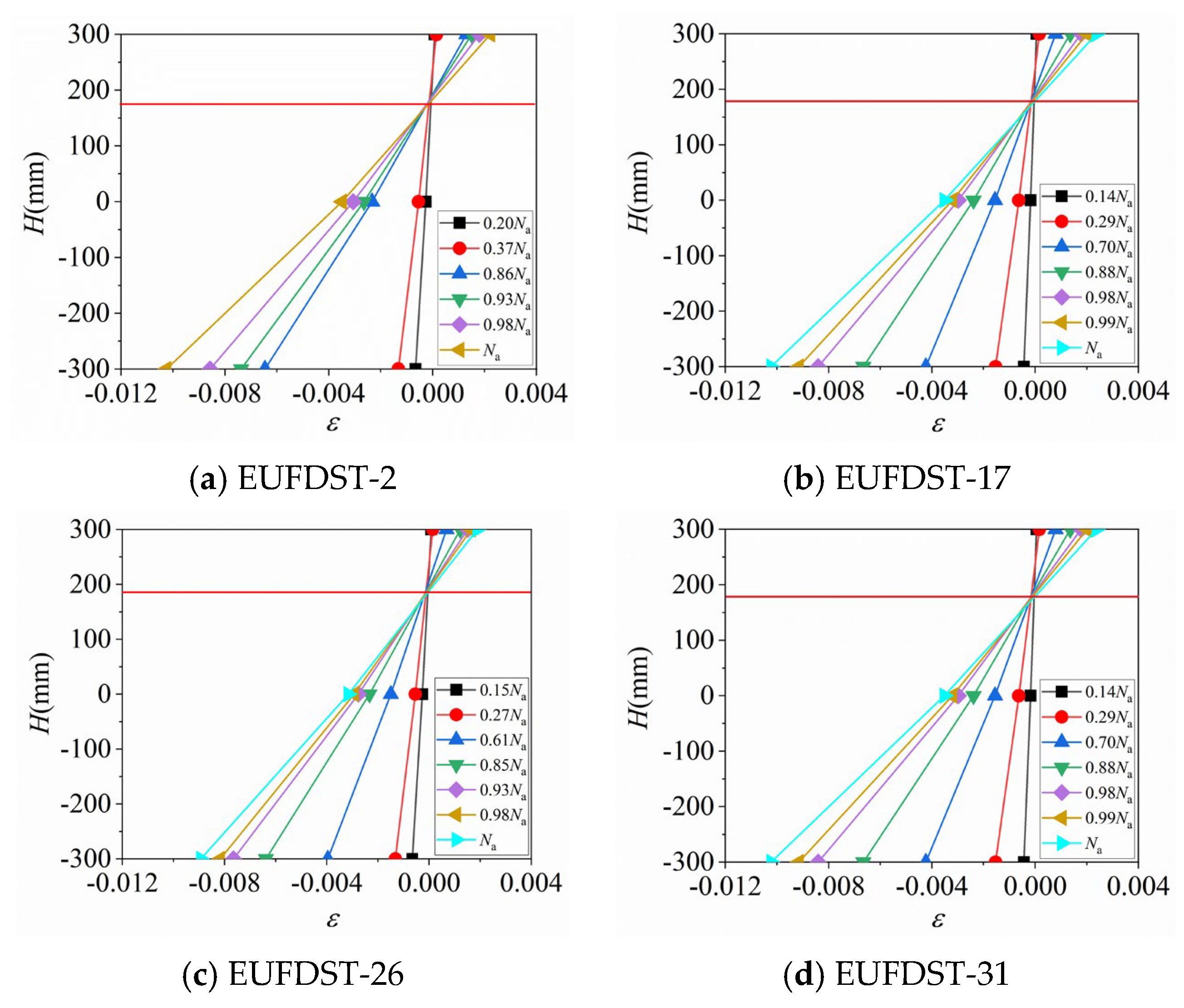
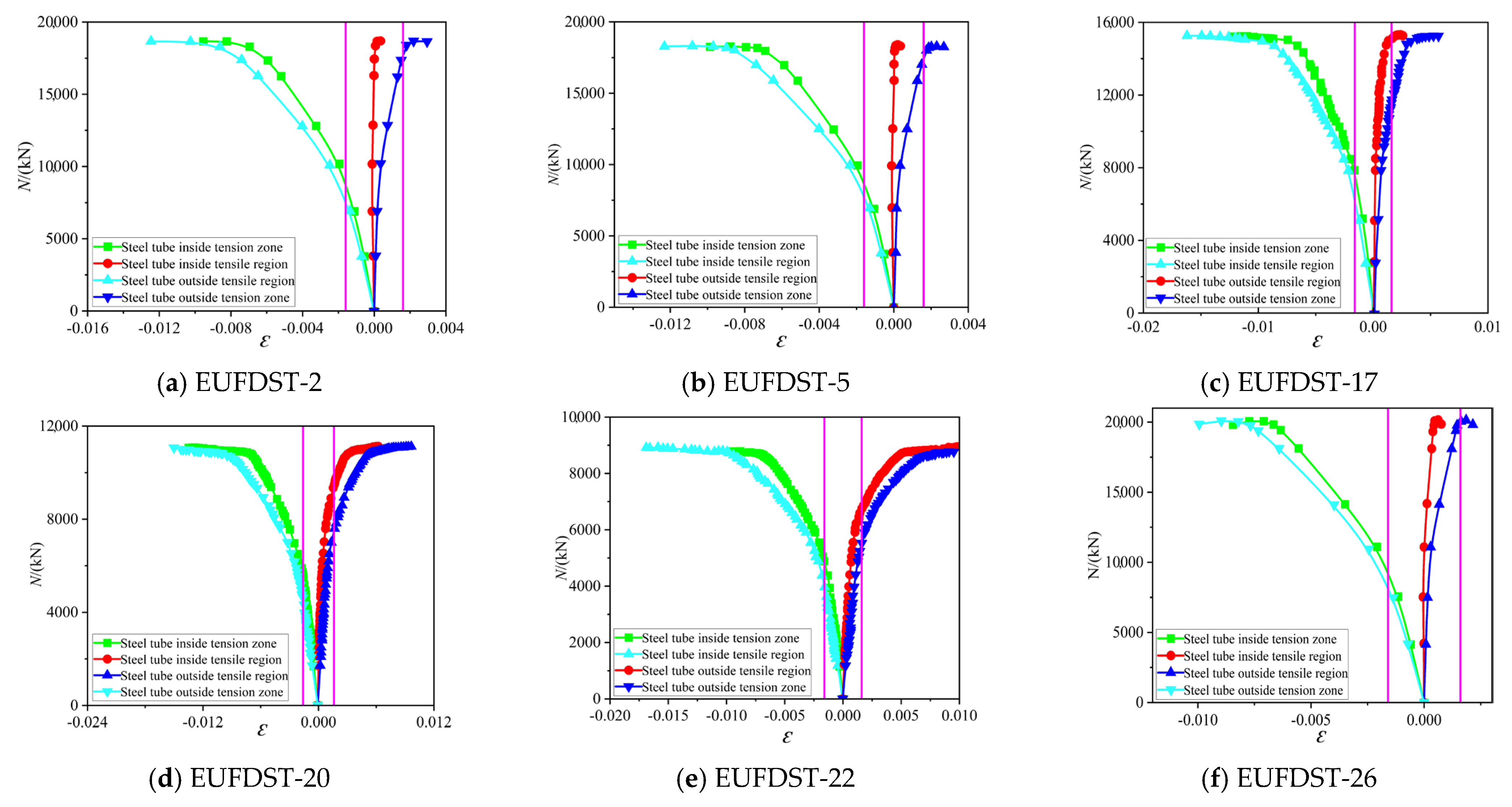

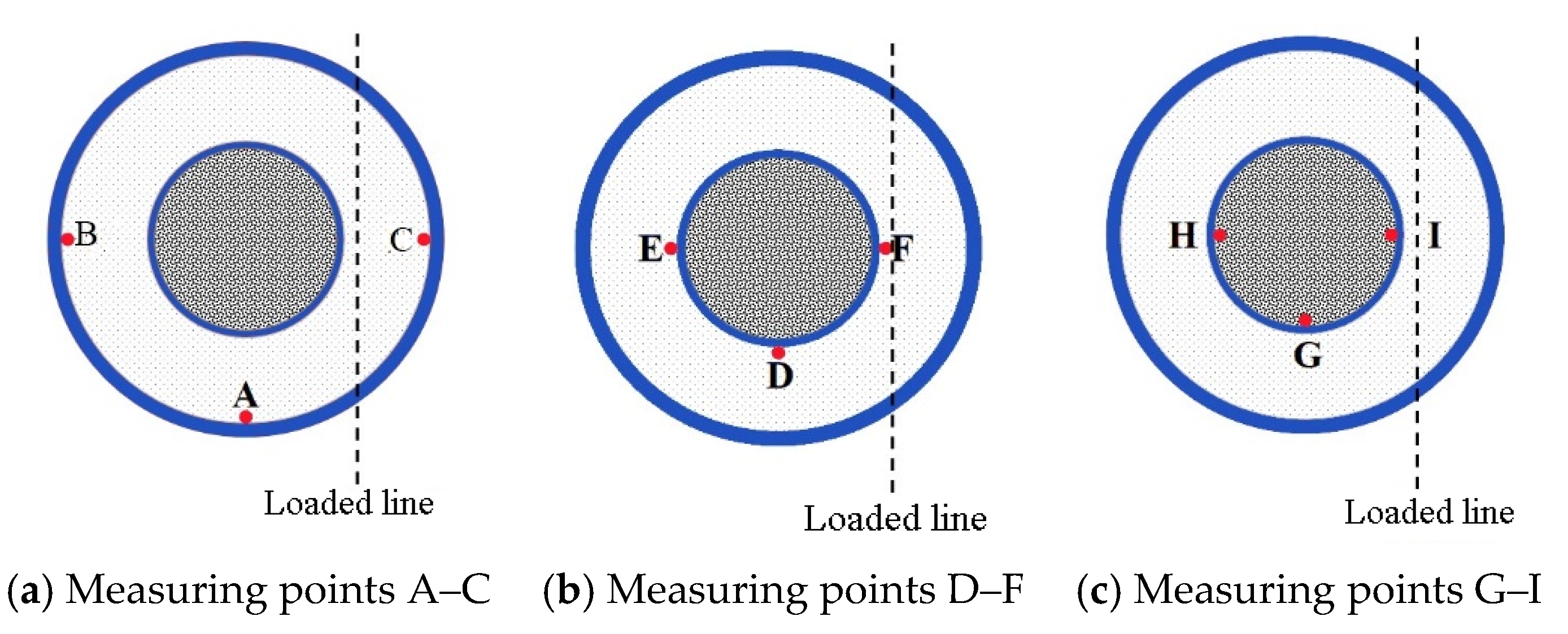
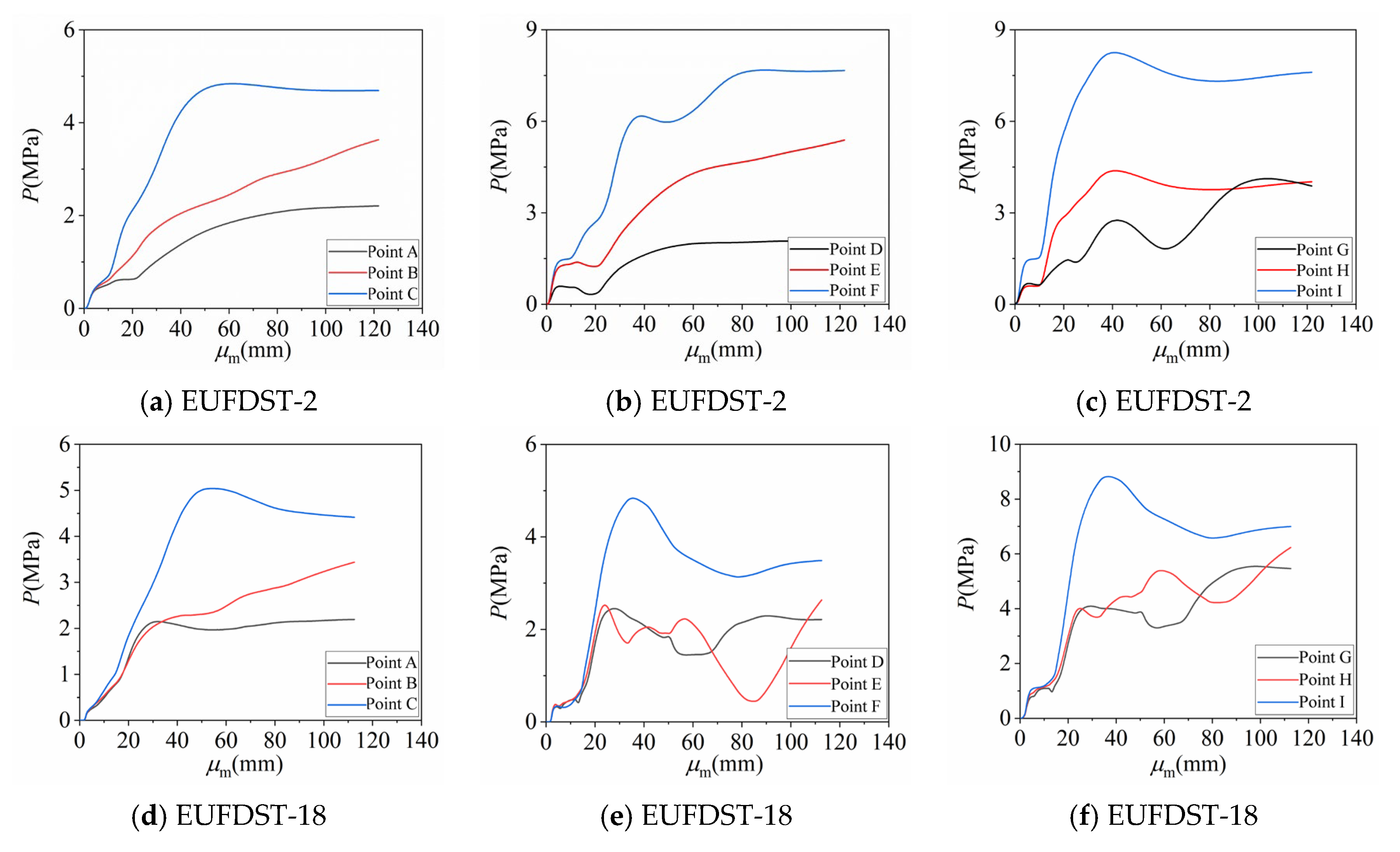

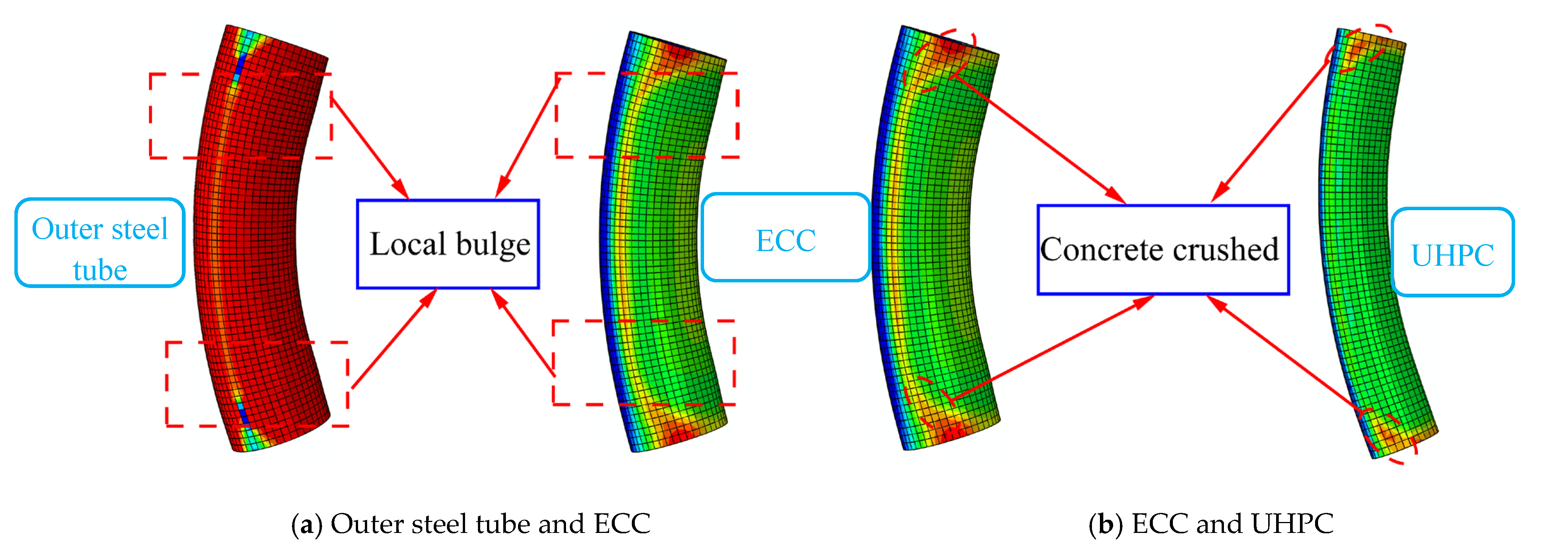


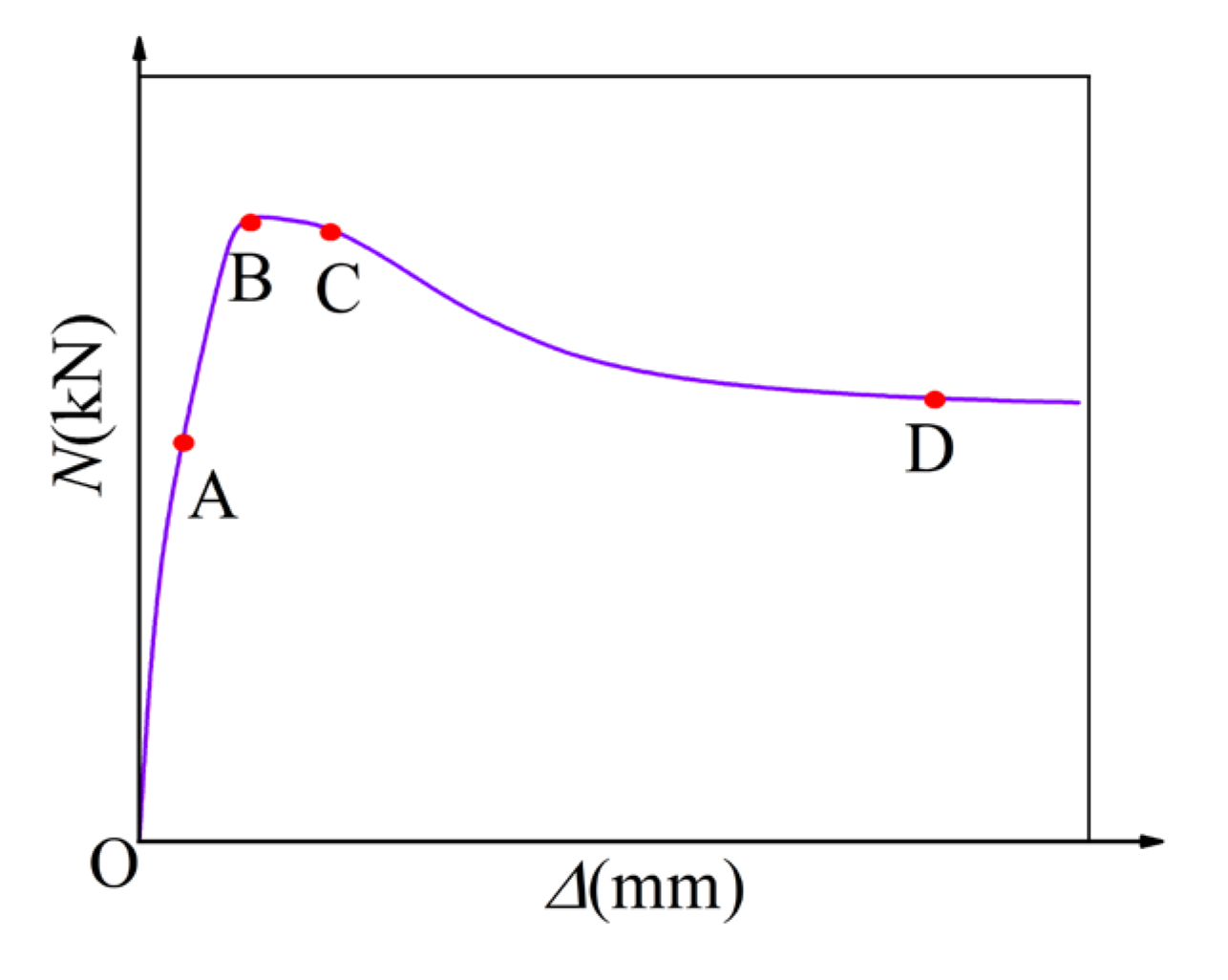



| Specimens | fcu /MPa | fy1 /MPa | fy2 /MPa | D1 /mm | D2 /mm | γ /% | t1 /mm | t2 /mm | e /mm | λ |
|---|---|---|---|---|---|---|---|---|---|---|
| EUFDST-1 | 120 | 235 | 335 | 600 | 400 | 1.2 | 10 | 5 | 100 | 4 |
| EUFDST-2 | 120 | 335 | 335 | 600 | 400 | 1.2 | 10 | 5 | 100 | 4 |
| EUFDST-3 | 120 | 435 | 335 | 600 | 400 | 1.2 | 10 | 5 | 100 | 4 |
| EUFDST-4 | 120 | 535 | 335 | 600 | 400 | 1.2 | 10 | 5 | 100 | 4 |
| EUFDST-5 | 120 | 335 | 235 | 600 | 400 | 1.2 | 10 | 5 | 100 | 4 |
| EUFDST-6 | 120 | 335 | 435 | 600 | 400 | 1.2 | 10 | 5 | 100 | 4 |
| EUFDST-7 | 120 | 335 | 535 | 600 | 400 | 1.2 | 10 | 5 | 100 | 4 |
| EUFDST-8 | 120 | 335 | 335 | 600 | 400 | 1.2 | 5 | 5 | 100 | 4 |
| EUFDST-9 | 120 | 335 | 335 | 600 | 400 | 1.2 | 15 | 5 | 100 | 4 |
| EUFDST-10 | 120 | 335 | 335 | 600 | 400 | 1.2 | 20 | 5 | 100 | 4 |
| EUFDST-11 | 120 | 335 | 335 | 600 | 400 | 1.2 | 5 | 10 | 100 | 4 |
| EUFDST-12 | 120 | 335 | 335 | 600 | 400 | 1.2 | 5 | 15 | 100 | 4 |
| EUFDST-13 | 120 | 335 | 335 | 600 | 400 | 1.2 | 5 | 20 | 100 | 4 |
| EUFDST-14 | 120 | 335 | 335 | 600 | 400 | 1.2 | 10 | 5 | 50 | 4 |
| EUFDST-15 | 120 | 335 | 335 | 600 | 400 | 1.2 | 10 | 5 | 75 | 4 |
| EUFDST-16 | 120 | 335 | 335 | 600 | 400 | 1.2 | 10 | 5 | 125 | 4 |
| EUFDST-17 | 120 | 335 | 335 | 600 | 400 | 1.2 | 10 | 5 | 150 | 4 |
| EUFDST-18 | 120 | 335 | 335 | 600 | 400 | 1.2 | 10 | 5 | 175 | 4 |
| EUFDST-19 | 120 | 335 | 335 | 600 | 400 | 1.2 | 10 | 5 | 200 | 4 |
| EUFDST-20 | 120 | 335 | 335 | 600 | 400 | 1.2 | 10 | 5 | 230 | 4 |
| EUFDST-21 | 120 | 335 | 335 | 600 | 400 | 1.2 | 10 | 5 | 260 | 4 |
| EUFDST-22 | 120 | 335 | 335 | 600 | 400 | 1.2 | 10 | 5 | 290 | 4 |
| EUFDST-23 | 120 | 335 | 335 | 600 | 240 | 1.2 | 10 | 5 | 100 | 4 |
| EUFDST-24 | 120 | 335 | 335 | 600 | 300 | 1.2 | 10 | 5 | 100 | 4 |
| EUFDST-25 | 120 | 335 | 335 | 600 | 360 | 1.2 | 10 | 5 | 100 | 4 |
| EUFDST-26 | 120 | 335 | 335 | 600 | 460 | 1.2 | 10 | 5 | 100 | 4 |
| EUFDST-27 | 120 | 335 | 335 | 600 | 400 | 1.2 | 10 | 5 | 100 | 3.5 |
| EUFDST-28 | 120 | 335 | 335 | 600 | 400 | 1.2 | 10 | 5 | 100 | 4.5 |
| EUFDST-29 | 120 | 335 | 335 | 600 | 400 | 1.2 | 10 | 5 | 100 | 5 |
| EUFDST-30 | 120 | 335 | 335 | 600 | 400 | 1.2 | 10 | 5 | 100 | 5.5 |
| EUFDST-31 | 120 | 335 | 335 | 600 | 400 | 1.2 | 10 | 5 | 100 | 6 |
| EUFDST-32 | 100 | 335 | 335 | 600 | 400 | 1.2 | 10 | 5 | 100 | 4 |
| EUFDST-33 | 140 | 335 | 335 | 600 | 400 | 1.2 | 10 | 5 | 100 | 4 |
| EUFDST-34 | 120 | 335 | 335 | 600 | 400 | 1.6 | 10 | 5 | 100 | 4 |
| EUFDST-35 | 120 | 335 | 335 | 600 | 400 | 2 | 10 | 5 | 100 | 4 |
| Specimens | t1 /mm | t2 /mm | fck1 × fck2 /MPa | D1 | D2 | L /mm | /kN | Mesh Size /mm | /kN | × 100% |
|---|---|---|---|---|---|---|---|---|---|---|
| 1 | 5 | 3.6 | 51.6 × 193.3 | 219.1 | 114.3 | 600 | 5317.2 | 15 | 5432.8 | 2.12 |
| 20 | 5239.8 | 1.47 | ||||||||
| 25 | 5201.6 | 2.22 | ||||||||
| 30 | 5148.5 | 3.28 | ||||||||
| 2 | 5 | 3.6 | 51.6 × 175 | 219.1 | 114.3 | 600 | 4895.5 | 15 | 5241.3 | 6.60 |
| 20 | 4968.2 | 1.49 | ||||||||
| 25 | 4786.1 | 2.29 | ||||||||
| 30 | 4745.3 | 3.17 |
| Specimens | t /mm | fy /MPa | fck /MPa | e /mm | L /mm | D/ mm | ξ | /kN | /kN | × 100% |
|---|---|---|---|---|---|---|---|---|---|---|
| U-1 | 4.4 | 1020 | 142.1 | 0 | 420 | 140 | 1.00 | 4436.12 | 4516.36 | 2.25 |
| U-2 | 6.2 | 1153 | 142.1 | 0 | 420 | 140 | 1.68 | 5582.38 | 5386.75 | 3.63 |
| U-3 | 10.4 | 773 | 142.1 | 0 | 420 | 140 | 1.66 | 6354.45 | 6339.26 | 0.53 |
| U-4 | 8.3 | 813 | 142.1 | 0 | 420 | 140 | 2.08 | 5310.30 | 5502.35 | 3.88 |
| U-5 | 6.2 | 359 | 142.1 | 0 | 420 | 140 | 0.52 | 3186.18 | 3202.47 | 4.73 |
| UP-1 | 6.2 | 1153 | 146.3 | 14 | 420 | 140 | 1.63 | 3810.36 | 3762.21 | 1.26 |
| UP-2 | 6.2 | 1153 | 146.3 | 42 | 420 | 140 | 1.63 | 2501.33 | 2479.02 | 0.90 |
| UP-3 | 6.2 | 1153 | 146.3 | 84 | 420 | 140 | 1.63 | 1694.94 | 1757.75 | 3.39 |
| Specimens | t1 /mm | t2 /mm | fck1 × fck2 /MPa | D1 /mm | D2 /mm | L /mm | /kN | /kN | × 100% |
|---|---|---|---|---|---|---|---|---|---|
| DC-1 | 5 | 3.6 | 51.6 × 51.6 | 219.1 | 114.3 | 600 | 3626.1 | 3688.3 | 1.68 |
| DC-2 | 5 | 3.6 | 175 × 175 | 219.1 | 114.3 | 600 | 8577.6 | 8529.5 | 0.56 |
| DC-3 | 5 | 3.6 | 51.6 × 175 | 219.1 | 114.3 | 600 | 4895.5 | 4968.2 | 1.49 |
| DC-4 | 5 | 3.6 | 51.6 × 193.3 | 219.1 | 114.3 | 600 | 5317.2 | 5239.8 | 1.47 |
| DC-8 | 10 | 6.3 | 51.6 × 193.3 | 219.1 | 114.3 | 600 | 7160.3 | 7074.1 | 1.22 |
| DC-9 | 6.3 | 6.3 | 163 × 163 | 219.1 | 114.3 | 600 | 7640.1 | 7507.2 | 1.77 |
| DC-11 | 6.3 | 6.3 | 148.8 × 148.8 | 219.1 | 114.3 | 600 | 6882.5 | 6835.7 | 0.69 |
| DC-12 | 6.3 | 6.3 | 175.4 × 175.4 | 219.1 | 114.3 | 600 | 8375.6 | 8455.3 | 0.95 |
| Specimens | t /mm | fy /MPa | γ | fck /MPa | /kN | /kN | × 100% |
|---|---|---|---|---|---|---|---|
| STCE40-52 | 2.70 | 300 | 2% | 31.2 | 872.46 | 929.03 | 6.09% |
| STCE40-35 | 4.00 | 295 | 2% | 31.2 | 1115.17 | 1096.23 | 1.73% |
| STCE60-52 | 2.70 | 300 | 2% | 49.0 | 1252.72 | 1270.25 | 1.42% |
| STCE60-35 | 4.00 | 295 | 2% | 49.0 | 1512.11 | 1474.36 | 2.58% |
| STCE60-70 | 2.00 | 310 | 2% | 49.0 | 1210.58 | 1182.99 | 2.37% |
| STCE60-82 | 1.71 | 330 | 2% | 49.0 | 1181.63 | 1138.71 | 3.78% |
| STCE80-70 | 2.00 | 310 | 2% | 65.9 | 1263.26 | 1223.44 | 3.27% |
| STCE80-82 | 1.71 | 330 | 2% | 65.9 | 1234.86 | 1176.73 | 4.93% |
| Specimens | fy1 /MPa | fy2 /MPa | e /mm | |||
|---|---|---|---|---|---|---|
| EUFDST-1 | 235 | 335 | 100 | 17,870.43 | 17,078.11 | 4.64 |
| EUFDST-2 | 335 | 335 | 100 | 19,270.09 | 18,713.53 | 2.97 |
| EUFDST-3 | 435 | 335 | 100 | 20,672.60 | 20,455.98 | 1.06 |
| EUFDST-4 | 535 | 335 | 100 | 22,077.29 | 22,051.87 | 0.12 |
| EUFDST-5 | 335 | 235 | 100 | 18,894.23 | 18,290.56 | 3.30 |
| EUFDST-6 | 335 | 435 | 100 | 19,649.02 | 19,262.17 | 2.01 |
| EUFDST-7 | 335 | 535 | 100 | 20,030.26 | 19,774.35 | 1.29 |
| EUFDST-8 | 335 | 335 | 100 | 17,170.26 | 16,322.86 | 5.19 |
| EUFDST-9 | 335 | 335 | 100 | 21,389.21 | 21,077.85 | 1.48 |
| EUFDST-10 | 335 | 335 | 100 | 23,528.87 | 23,295.45 | 1.00 |
| EUFDST-11 | 335 | 335 | 100 | 18,054.02 | 17,663.71 | 2.21 |
| EUFDST-12 | 335 | 335 | 100 | 18,941.38 | 19,230.63 | 1.50 |
| EUFDST-13 | 335 | 335 | 100 | 19,818.21 | 20,329.92 | 2.52 |
| EUFDST-14 | 335 | 335 | 50 | 23,408.91 | 23,298.6 | 0.47 |
| EUFDST-15 | 335 | 335 | 75 | 21,302.25 | 20,995.93 | 1.46 |
| EUFDST-16 | 335 | 335 | 125 | 17,338.43 | 16,918.25 | 2.48 |
| EUFDST-17 | 335 | 335 | 150 | 15,533.50 | 15,261.86 | 1.78 |
| EUFDST-18 | 335 | 335 | 175 | 13,881.71 | 13,722.65 | 1.16 |
| EUFDST-19 | 335 | 335 | 200 | 12,409.65 | 12,455.19 | 0.36 |
| EUFDST-20 | 335 | 335 | 230 | 10,918.08 | 11,063.38 | 1.31 |
| EUFDST-21 | 335 | 335 | 260 | 9770.28 | 9899.51 | 1.31 |
| EUFDST-22 | 335 | 335 | 290 | 9012.95 | 8901.11 | 1.26 |
| EUFDST-23 | 335 | 335 | 100 | 18,577.42 | 18,617.77 | 0.22 |
| EUFDST-24 | 335 | 335 | 100 | 18,997.61 | 18,588.72 | 2.20 |
| EUFDST-25 | 335 | 335 | 100 | 17,677.61 | 18,723.93 | 5.59 |
| EUFDST-26 | 335 | 335 | 100 | 21,934.83 | 20,138.27 | 8.92 |
| EUFDST-27 | 335 | 335 | 100 | 18,941.67 | 18,928.32 | 0.07 |
| EUFDST-28 | 335 | 335 | 100 | 18,812.10 | 18,568.11 | 1.31 |
| EUFDST-29 | 335 | 335 | 100 | 18,571.36 | 18,416.26 | 0.84 |
| EUFDST-30 | 335 | 335 | 100 | 18,329.79 | 18,265.75 | 0.35 |
| EUFDST-31 | 335 | 335 | 100 | 18,088.16 | 18,271.53 | 1.00 |
| EUFDST-32 | 335 | 335 | 100 | 17,641.76 | 18,217.82 | 3.16 |
| EUFDST-33 | 335 | 335 | 100 | 20,879.27 | 19,657.82 | 6.21 |
| EUFDST-34 | 335 | 335 | 100 | 19,441.81 | 19,274.91 | 0.87 |
| EUFDST-35 | 335 | 335 | 100 | 19,613.33 | 20,584.23 | 4.72 |
Disclaimer/Publisher’s Note: The statements, opinions and data contained in all publications are solely those of the individual author(s) and contributor(s) and not of MDPI and/or the editor(s). MDPI and/or the editor(s) disclaim responsibility for any injury to people or property resulting from any ideas, methods, instructions or products referred to in the content. |
© 2024 by the authors. Licensee MDPI, Basel, Switzerland. This article is an open access article distributed under the terms and conditions of the Creative Commons Attribution (CC BY) license (https://creativecommons.org/licenses/by/4.0/).
Share and Cite
Jiang, L.; Hong, Y.; Ji, J.; Liu, Y.; Zhang, Z.; Chu, X.; Ma, G. Bearing Behavior of Engineered Cementitious Composite and Ultra-High-Performance Concrete Filled-In Double Steel Tubular Composite Columns Subjected to Eccentrical Load. Buildings 2024, 14, 1487. https://doi.org/10.3390/buildings14051487
Jiang L, Hong Y, Ji J, Liu Y, Zhang Z, Chu X, Ma G. Bearing Behavior of Engineered Cementitious Composite and Ultra-High-Performance Concrete Filled-In Double Steel Tubular Composite Columns Subjected to Eccentrical Load. Buildings. 2024; 14(5):1487. https://doi.org/10.3390/buildings14051487
Chicago/Turabian StyleJiang, Liangqin, Yigang Hong, Jing Ji, Yingchun Liu, Zhanbin Zhang, Xuan Chu, and Guiling Ma. 2024. "Bearing Behavior of Engineered Cementitious Composite and Ultra-High-Performance Concrete Filled-In Double Steel Tubular Composite Columns Subjected to Eccentrical Load" Buildings 14, no. 5: 1487. https://doi.org/10.3390/buildings14051487
APA StyleJiang, L., Hong, Y., Ji, J., Liu, Y., Zhang, Z., Chu, X., & Ma, G. (2024). Bearing Behavior of Engineered Cementitious Composite and Ultra-High-Performance Concrete Filled-In Double Steel Tubular Composite Columns Subjected to Eccentrical Load. Buildings, 14(5), 1487. https://doi.org/10.3390/buildings14051487






